Rehabilitating Mines
Snapshot
Is the state effectively managing its exposure to liabilities from the rehabilitation of mines on private and public land?
Why this audit is important
Since Victoria’s gold rush in the 1850s, the state’s mining and quarry industries have boosted our economy. They help deliver electricity, underpin building and construction, create jobs, and attract investments for the state.
Mining and quarrying can also cause environmental damage. Recognising this, the Mineral Resources (Sustainable Development) Act 1990 (the Act) aims to achieve a balance. It encourages mineral exploration and operations, while ensuring risks to the environment and community are identified and eliminated or minimised.
Site rehabilitation is a key part of minimising risks to the public, the environment, property or infrastructure. Rehabilitation aims to make mine and quarry sites safe, stable and sustainable. Mine and quarry operators are responsible for rehabilitation works, with the anticipated cost secured by a bond. However, if the operator defaults on their rehabilitation responsibilities, the cost to restore the land may fall on the state.
What and who we examined
The Department of Jobs, Precincts and Regions (DJPR) regulates mining rehabilitation through its Earth Resources Regulation (ERR) unit. This audit examined whether its work minimises the state’s exposure to rehabilitation liabilities. We also examined how DJPR and the Department of Environment, Land, Water and Planning (DELWP) identify and manage rehabilitation liabilities from abandoned and legacy sites.
We also considered DJPR’s coordination with relevant agencies, including DELWP, the Environment Protection Authority Victoria (EPA), the Latrobe Valley Mine Rehabilitation Commissioner (LVMRC) and the Goulburn Broken Catchment Management Authority (GBCMA).
What we concluded
DJPR is not effectively regulating operators’ compliance with their rehabilitation responsibilities. This exposes the state to significant financial risk because some sites have been poorly rehabilitated or not treated at all. If not addressed, these sites also present risks to Victorians and the environment.
Systemic regulatory failures encompass:
- using outdated cost estimates
- not periodically reviewing bonds for their sufficiency—including a four-year bond review ‘moratorium’ for which there is no documentary evidence that it was duly authorised
- failure to assure that site rehabilitation had actually occurred before returning bonds
- approving inadequately specified rehabilitation plans
- lack of enforcement activities.
Further, while some changes to address conflicts of interest were made following Parliament’s Independent Inquiry into the EPA in 2016, ERR—the primary mining regulator—still resides within DJPR, which seeks to foster and develop the mining industry.
ERR acknowledges that it has not effectively discharged its responsibilities and is working to rectify identified issues. Following the recommendations of the 2014 and 2016 inquiries into the Hazelwood mine fire, ERR began improving its regulatory performance. However, its early reforms were broad, and it was not until mid-2018 that ERR started specifically addressing rehabilitation issues.
Video presentation
What we found and recommend
We consulted with the audited agencies and considered their views when reaching our conclusions. The agencies’ full responses are in Appendix A.
Rehabilitation liabilities
Rehabilitation bonds held by the state
ERR holds $813 million in rehabilitation bonds. This comprises:
- $591 million (73 per cent) for the three coal mines in the Latrobe Valley—the largest mines in Victoria
- $222 million (27 per cent) for the other 1 391 mines and quarries across the state.
ERR acknowledges that bonds for many Victorian mines and quarries do not cover actual rehabilitation costs.
To scope and plan future regulatory actions, ERR did a preliminary assessment of how much it would cost to rehabilitate Victoria’s mines and quarries. It found that the $813 million figure may be $361 million short. ERR advised that this is an estimate only and that it will conduct further reviews to more accurately determine total rehabilitation costs.
It is likely that $361 million is a low estimate because the assessment was done largely as a desktop analysis. It automatically applied:
- $10 000 as the estimated restoration cost for over 500 mines and quarries that currently have less than $10 000 in rehabilitation bonds
- a modest 10 per cent increase in restoration costs for over 800 sites that currently have at least $10 000 in rehabilitation bonds.
Low-value rehabilitation bonds
According to available ERR data, there are 1 394 mines and quarries across the state that should have rehabilitation bonds.
Nearly 89 per cent of these, or 1 239, have rehabilitation bonds of less than $200 000. For 526 of these (covered by mining licences and work authorities), the bond value is $10 000 or less.
This is not sufficient to cover rehabilitation costs.
ERR’s 2010 Establishment and Management of Rehabilitation Bonds for the Mining and Extractive Industries (Bond Policy) requires a standard bond rate of $4 000 per hectare for small and low-risk quarries. These are defined as less than five hectares in area, less than five metres in depth, and not requiring blasting or native vegetation clearance.
However, we identified 275 mining licences and work authorities—whose operations do not meet the definition of ‘small and low risk’—with bond amounts below the $4 000 per hectare rate. These include 100-hectare gold mines.
ERR contests this comparison and maintains that for sites larger than five hectares, the $4 000 per hectare rate should only be applied to the disturbed area and not the entire licence area. However, applying the $4 000 per hectare rate on the disturbed area—instead of the whole site—still reveals significant shortfalls.
Rehabilitation bonds are meant to ensure that the state has funds to restore sites if operators do not. The fact that many sites have bonds that are less than what is deemed sufficient means that the state is potentially exposed to significant financial risk.
Lack of rehabilitation bonds
According to available ERR data, 578 mining and quarry sites have no rehabilitation bonds.
Within this group, we were able to identify 24 sites that are actively operating and 14 inactive sites that are no longer operating but are yet to be rehabilitated. This means that ERR has breached its regulatory responsibilities, because the Act requires mines and quarries to have rehabilitation bonds before:
- obtaining their quarry work authorities
- beginning ground operations for mines.
For the remaining 540 sites, ERR said that reasons for the lack of a bond include:
- that the bond had been returned to the operator at completion of rehabilitation
- the sites are not yet operating.
However, ERR was unable to provide documentation to show this. ERR acknowledged that its limited record keeping and information management systems contribute to its inability to confirm why there are no recorded bonds for these sites.
The state’s contingent liability
Contingent liability (CL) is the cost the state could become responsible for if operators fail to rehabilitate their mine or quarry sites. DJPR reported in its 2018–19 Annual Report that this stood at $29.8 million as at 30 June 2019.
This is significantly higher than the $1.7 million CL reported as at 30 June 2018 in the then Department of Economic Development, Jobs, Transport and Resources' (DEDJTR) 2017–18 Annual Report. The difference is not due to increased risks, but to ERR’s earlier lack of rigour in determining the state’s position.
ERR’s 2019 Rehabilitation Bond Review Operational Policy informed its determination of the state’s mining rehabilitation CL for 2018–19. In estimating the $29.8 million CL, ERR considered the:
- difference between current rehabilitation bond value and estimated actual rehabilitation liability (the preliminary assessment referred to earlier)
- the likelihood of an operator defaulting on their rehabilitation obligations (financial standing and resource depletion), and
- the consequences of an operator defaulting.
ERR is working to further refine its assessment of the state’s potential mining liabilities. In November 2019, it advised us that the state’s CL could be $50 million for all Victorian earth resources sites.
It is expected that DJPR will again report on the state’s mining CL in its 2019–20 annual report.
Regulating rehabilitation bonds
ERR’s ineffective regulation of rehabilitation bonds means that the state is financially exposed to significant costs.
Setting the rehabilitation bond amount
ERR has not effectively calculated and set rehabilitation bonds to cover the full cost of rehabilitating mines and quarries.
ERR last updated its rehabilitation bond calculator in September 2010. Therefore, its input rates do not reflect the 19.8 per cent increase in the consumer price index from 2010 until 2019.
ERR’s calculator also does not account for factors that affect rehabilitation costs such as:
- site remoteness
- potential resources required for rehabilitation, such as water
- operations in areas of high environmental sensitivity.
ERR is aware of these issues and advised it is on track to release an updated bond calculator by December 2020. However, due to the economic uncertainty caused by the COVID-19 pandemic, ERR postponed its March 2020 stakeholder consultations on the revisions to the bond calculator.
Process for returning rehabilitation bonds
ERR cannot demonstrate that it ensures a mine or quarry site has been rehabilitated before returning the bond to the operator. This includes ensuring that the state has no remaining liability.
Inconsistent application of ERR’s bond return process, and limitations in its record keeping, mean that ERR is unable to provide assurance that it undertakes assessments to ensure satisfactory rehabilitation in all cases. While we sighted some field entry reports evidencing site inspections, these vary in detail and do not include all the required rehabilitation information.
This means that even though ERR complies with the requirement to consult with the landowner, council and the Crown land manager, where appropriate, it cannot assure that these sites have been rehabilitated as required, and that the state therefore has no remaining liability.
ERR advised that it is developing an updated version of the bond return process to align with its assignment of staff responsibilities for site rehabilitation and other process improvements.
Conducting bond reviews
ERR conducted bond reviews for the Latrobe Valley coal mines following the findings of the 2016 Hazelwood Mine Fire Inquiry Report Volume IV—Mine Rehabilitation. However, it has not reviewed most rehabilitation bonds for Victoria’s mines and quarries in accordance with the Bond Policy.
The Bond Policy requires ERR to periodically review all rehabilitation bonds to ensure that the financial security remains at an appropriate level. The Bond Policy’s recommended frequency for bond reviews is set out in Figure 1G.
Available data shows that:
- ERR is on track with its review of 8.3 per cent of rehabilitation bonds
- 91.7 per cent are not on track, of which:
- 68.6 per cent are overdue for review, by up to 23 years (and nine years on average).
- 23.1 per cent do not have a scheduled next review. ERR records suggest that nearly half of these have not been reviewed since their licences and work authorities were first granted between 1988 and 2015.
This failing means ERR cannot assure that bond values reflect what it would cost to undertake rehabilitation if an operator defaults.
Bond review moratorium
ERR acknowledges that a bond review moratorium was in place from 2013 to 2017, but cannot provide documentary evidence about its:
- approval in 2013
- announcement to ERR staff and stakeholders
- guidance to staff on its implementation
- termination in 2017.
A moratorium is an allowed period of time to suspend the performance of a task or obligation.
A moratorium is not consistent with the Bond Policy’s requirement that ERR periodically review rehabilitation bonds.
The lack of documentation to demonstrate when, why and by whom the moratorium was approved and later lifted, breaches the principles of transparency and accountability. Clear documentation of the rationale and approval process is important, as the decision clearly benefited mine and quarry operators, potentially to the detriment of the environmental protections that are intended by the Act and the Bond Policy.
Conflict of interest
The 2016 parliamentary Independent Inquiry into the EPA raised concerns about the conflict of interest in having ERR—the primary mining regulator—as a unit within DJPR, the department responsible for fostering and developing the mining industry. It noted that ERR had not regulated the environmental and public health risks associated with mining operations to the same level as other industries with similar environmental risk profiles.
To address these concerns, the inquiry recommended that EPA play a greater role in mining regulation. The government supported this in principle and amended the Act to provide for the mandatory referral of mining work plan applications to EPA from 1 July 2019.
However, EPA’s additional role to review work plans is unlikely to be sufficient to address the conflict of interest. This is because most of the regulatory responsibilities continue to lie solely with ERR, particularly the compliance and enforcement of environmental conditions.
Regulating rehabilitation
ERR’s regulation of mining rehabilitation does not meet its responsibilities under the Act, relevant regulations and policies. Until regulation is effective, ERR will not be able to:
- incentivise operators’ compliance with their rehabilitation responsibilities
- limit the government’s exposure to rehabilitation liabilities.
One consequence of ERR’s failure to monitor operators’ compliance with their rehabilitation responsibilities is that some mining licences become inactive before rehabilitation works are finished or even begun.
This increases the risk of the state needing to take on a rehabilitation liability due to a mining operator not acting as required by the Act.
Rehabilitation plans
A rehabilitation plan documents potential risks to the environment and public safety, and how these risks could be minimised through progressive and final rehabilitation.
Comprehensive and unambiguous rehabilitation plans are therefore the first step to effective rehabilitation. However, the rehabilitation plans we reviewed were not written with sufficient detail.
ERR generally complies with requirements to consult with the landowner, council, local community, catchment management authorities and Crown land managers, where appropriate, when assessing work plans and their associated rehabilitation plans. However, of the 18 plans we reviewed, 13 (72 per cent) do not have the detail required by the Act, Mineral Resources (Sustainable Development) (Mineral Industries) Regulations 2019 (MRSDMIR) and Mineral Resources (Sustainable Development) (Extractive Industries) Regulations 2019 (MRSDEIR). Statistically, this indicates that it is highly likely that more than half of all approved rehabilitation plans are non compliant.
If ERR continues to approve rehabilitation plans that do not meet the requirements of the Act and regulations, then the associated rehabilitation bonds will not cover the true cost of rehabilitation.
|
Of the 18 rehabilitation plans reviewed ... |
Meaning ... |
|
Four have rehabilitation plans that are vague and do not have the required information. For example, one plan references itself: ‘Rehabilitation Plan: Progressive and final rehabilitation must be undertaken in accordance with the approved rehabilitation plan and any additional requirements as and when directed by the Inspector’. This is the entire rehabilitation plan. |
Neither the operators nor ERR has a clear understanding of the cost required to complete rehabilitation. This makes it difficult to set effective rehabilitation bonds. |
|
Nine have some, but not all of the required information. |
These plans provide high-level information and are unclear on important aspects of the rehabilitation plan, such as how progressive rehabilitation will be carried out and what final landform is proposed. |
|
Five have all the details required by the Act and the regulations. |
28 per cent of our sample is fully compliant. |
DELWP also noted that ERR has not always strictly enforced the rehabilitation plan requirements of the Act, MRSDMIR and MRSDEIR.
Consequently, DELWP, which manages Crown land, advised us that it has often been left with unrehabilitated or poorly rehabilitated mine and quarry sites.
Monitoring rehabilitation
ERR is unable to provide evidence of the extent to which operators comply with their rehabilitation obligations. This is because its monitoring program has not prioritised determining whether operators are:
- progressively rehabilitating mining sites during operations, or
- completing rehabilitation after operations.
While ERR’s annual statistical reports say that it conducts inspections and audits every year, less than 10 per cent of these check operators’ rehabilitation activities. Moreover, ERR's rehabilitation-specific checks have not been appropriately informed by risk considerations.
Annual reporting of rehabilitation information
Mining operators submit annual expenditure and activities return reports to ERR. However, while ERR checks whether operators submit these, it does not assess whether the responses are complete or reasonable. ERR advised us that this is because it does not have the resources to do so.
This is a missed opportunity, because the information provided in annual returns— rehabilitation works, expenditure and liabilities—could help ERR identify non-compliance with rehabilitation requirements. Information from annual returns could also better inform ERR’s rehabilitation risk rating of mines and quarries.
Enforcement
None of the 262 enforcement notices that ERR issued from 2011–12 to 2018–19 relate to operators’ breaches of their rehabilitation responsibilities.
Since 2016, ERR has begun court proceedings against five mine and quarry operators for breaches of the Act and regulations. However, it has not prosecuted any rehabilitation-specific breach or non-compliance.
Outcomes of poor rehabilitation regulation
Without effective monitoring, mining licences and work authorities may become inactive with rehabilitation works not having been completed or even started.
This increases the state’s risk of absorbing rehabilitation liabilities, which the Act requires mine and quarry operators to bear.
Inactive mines and quarries
ERR categorises licences and work authorities as either ‘Active’ (current, not expired, not suspended, ongoing), ‘Inactive’ (expired, suspended, surrendered, not renewed but not yet rehabilitated), and ‘Fully released/Called in’ (final rehabilitation completed and bond is returned, or not rehabilitated and the bond was called in).
As at 30 September 2019, available ERR data suggests that there were 231 inactive mines and quarries across the state. These are unrehabilitated sites that are no longer operating but still have an operator on record.
ERR does not have processes to effectively guide staff on how to regulate inactive mines and quarries. This results in sites remaining ‘inactive’ for an indeterminate amount of time with little or no rehabilitation taking place.
ERR advised us that while these 231 inactive sites are within its scope of regulation, it does not have adequate resources to inspect them and compel rehabilitation. Its inspectors’ workloads are taken up with overseeing active sites.
Abandoned mines and legacy mines and quarries
The 2019 Australian Senate Inquiry into the Rehabilitation of Mining and Resources Projects said that there are an estimated 19 000 locations across the state where evidence of previous mining or quarrying activities, such as a mine shaft, have been identified. DELWP advised us that the actual number is significantly higher.
ERR classifies vacated, unrehabilitated sites—where the responsibility for rehabilitation can no longer be allocated to any individual or company—as either legacy or abandoned based on when mining operations ceased. Those that stopped mining activities after the Act came into effect in 1990 are classified as abandoned. Those that stopped before 1990 are legacy.
ERR is unable to advise us on the number of abandoned sites. DELWP also does not have reliable and comprehensive records on legacy and abandoned sites on Victorian Crown land.
There is no statewide approach to managing abandoned and legacy sites to reduce their environmental, public health and safety risks.
As a result, there has been an ad hoc, uncoordinated and reactive approach to managing abandoned and legacy sites across the state.
To address this issue, DELWP and DJPR advised us that:
- DELWP is responsible for legacy mines and quarries on Crown land.
- The Minister for Resources may take action to rehabilitate land if they are not satisfied that rehabilitation has been appropriately undertaken and the licence holder or former licence holder has failed to do so in a reasonable time.
- Going forward, DJPR, in partnership with DELWP, will typically lead rehabilitation works on abandoned sites on Crown land.
- DELWP would not immediately take on responsibility for all abandoned mines and quarries on Crown land as there may be bonds or other consolidated funds available to DJPR to rehabilitate the site.
DELWP and ERR are working on a joint departmental statement regarding their shared position on managing legacy and abandoned sites on Crown land. They advised that this statement will be published by 31 December 2020.
Better-practice management of abandoned and legacy mines
Victoria is not as well placed as other jurisdictions to manage the risks from abandoned and legacy mines. DELWP and DJPR acknowledge that the state does not have the following components of better practice found in other jurisdictions:
- abandoned and legacy mines and quarries policy
- risk assessment matrix and risk register
- established database for abandoned and legacy sites
- dedicated funding for rehabilitation
- designated responsible agency branch or unit.
No comprehensive record on rehabilitation works and costs
Other than for rehabilitation of the Benambra mine in East Gippsland at the cost of $5.6 million as at November 2019, ERR is unable to provide information about other instances when the state rehabilitated mines or quarry sites under the Act.
When we requested this information, ERR provided a list of 19 mines and quarries whose bonds were allegedly called in to finance the sites’ rehabilitation. However, the list does not include information on whether rehabilitation was completed or even begun. Moreover, ERR’s rehabilitation bonds data shows that it has in fact not called in any of these bonds.
ERR acknowledges that it has not prosecuted any licence holder to enforce rehabilitation or to recoup additional costs of rehabilitation incurred by the state.
Also, DELWP does not centrally record rehabilitation work conducted by its regional offices, or the corresponding expenditure. We found that DELWP regional offices record this information in varying level of detail.
DELWP action on legacy mines and quarries
DELWP has no centralised approach to manage legacy sites on Crown land. This means that regional offices’ management of legacy sites is reactive, uncoordinated and not uniform.
However, DELWP actively manages known legacy sites with immediate risks to the environment or public safety. DELWP advised us that its officers come across legacy sites in the course of other work, such as managing bushfire risks, implementing weed and pest programs or providing recreational services. In these cases, if the site poses a risk to human health and the environment, DELWP officers work to manage the risks through methods such as fencing, backfilling, capping or grate installation.
DELWP’s new approach to managing contaminated land
DELWP advised us that it is developing a new approach to better manage risks associated with contaminated land, including abandoned or legacy sites.
This work is in response to the introduction of the Environment Protection Act 2017 (as amended), which imposes a duty on DELWP, as Crown land manager, to manage contaminated land and minimise risks to human health and the environment as far as reasonably practicable.
Regulator readiness
ERR acknowledges the need to improve the regulation of mining rehabilitation and is working to rectify identified issues.
ERR’s policies and guidance documents do not support its effective regulation of rehabilitation liabilities as required by the Act. They do not enable ERR to effectively oversee the sector or set enforceable requirements to encourage mining operators to comply with their rehabilitation obligations.
Further, ERR has no integrated information management system. Where information is available, it holds it in fragmented systems. There is no easy way to collate or retrieve information to provide an auditable trail of rehabilitation compliance.
These factors have resulted in ineffective compliance and enforcement, leaving the state at risk of taking responsibility for poorly rehabilitated mining and quarrying sites.
Finally, despite recent changes to address it, the conflict of interest remains in having the primary mining regulator—ERR—reside within DJPR, which seeks to foster and develop the mining industry.
Policies and procedures
While ERR has a number of policies and guidance documents to manage rehabilitation liabilities, these are fragmented, often outdated and inconsistently applied. They are also used infrequently, as staff are often unaware of them.
This has resulted in blurred accountabilities, inconsistent application across regions and weak oversight, which inhibits ERR from effectively implementing the Act’s requirements.
To address this, ERR developed standard operating procedures (SOP) to support consistent and compliant regulatory practices. However, other than the 2019 Rehabilitation Bond Review Operational Policy and the 2020 Preparation of Rehabilitation Plans: Guideline for Mining and Prospecting Projects, ERR’s SOPs do not provide sufficient guidance on managing rehabilitation responsibilities.
None of the completed policies and procedures provide guidance on how to:
- set and review rehabilitation bonds
- monitor and enforce progressive rehabilitation
- assess compliance with final rehabilitation requirements.
ERR is continuing work on addressing the gaps in its operational policies and process documents. On 7 February 2020, the Minister for Resources approved ERR’s Regulatory Practice Strategy for the Rehabilitation of Earth Resources Sites.
This document outlines ERR’s rehabilitation responsibilities throughout the mine or quarry life cycle. It should help ERR better manage its mining rehabilitation regulatory responsibilities.
ERR resourcing
ERR advised us that lack of staff is a significant hurdle in performing its rehabilitation responsibilities. Only one staff member is responsible for rehabilitation liability assessments and ERR staffing has not increased despite its increased workload.
ERR belongs to DJPR's Resources Branch. In 2019, the branch commissioned a review of its workforce capabilities and capacity to inform future resource planning for its various units. The November 2019 report for this review noted that:
- ERR’s workload has sharply increased due to high demand for quarry materials and more mineral production. The increased workload has resulted in capacity issues in mining rehabilitation, regulatory compliance, investigations, assessments and risk management.
- The ratio of inspectors to sites and active issues does not allow for effective regulation and compliance, and the backlog of work is growing.
To determine its staff requirements, ERR’s Senior Management Committee conducted a workshop to consider current and anticipated future workload requirements. The workshop identified the need for additional 25.1 full-time equivalents (FTE) to address resourcing gaps in regulating rehabilitation.
Information management system
ERR has no centralised information management system for mining rehabilitation information.
Where information is available, it is held in fragmented and disparate systems across ERR offices. Other issues include:
- ERR’s electronic document management solution:
- is not compliant with the Public Records Act 1973, the Evidence Act 2008, Financial Management Act 1994, and the Electronic Transactions Act 2000, as identified in its 2017 internal audit
- is not fit for document retention and management, given the lack of validation controls, business continuity and disaster recovery planning
- inconsistent and siloed document management practices across the regions, as there is no ERR-wide SOP for document management and retention
- inadequate physical security for hard copy documents, leading to missing documentation and increased risk of information being fragmented, incomplete, inaccurate or out of date.
In December 2019, ERR approved a digitisation plan to make hard copy files available electronically and incorporate them in its electronic data management system.
In February 2020, ERR approved a project to develop its Resources Management System Victoria—a replacement for its current electronic data management system. ERR advised us that subject to funding availability, the project is scheduled for completion by 31 December 2021.
Roles and responsibilities across agencies and within ERR
Following ERR’s implementation of recommendations from the 2016 EPA Inquiry and the 2014 Hazelwood mine fire report, responsible agencies have a clearer understanding of their roles and responsibilities in the earth resources sector.
ERR’s 2019 Assignment of Rehabilitation Responsibilities clarified the roles and responsibilities of the various units in ERR.
However, ERR still needs to address issues with its memoranda of understanding (MoU) with DELWP and EPA, and its coordination with LVMRC and catchment management authorities.
MoUs with DELWP and EPA
Figure A lists the issues with ERR’s MoUs with DELWP and EPA.
FIGURE A: ERR’s MoUs with DELWP and EPA
| MoU | Issues |
|---|---|
| DELWP | The 2011 MoU between ERR and DELWP expired in 2016 and needs to be updated to reflect recent changes in legislation and regulations. The MoU is also silent on responsibilities including for:
|
| EPA | The 2018 MoU with EPA does not reflect the Act’s requirement to refer mining work plans to EPA, where a planning permit is required. ERR and EPA began implementing this on 1 July 2019, as required by the Act, and are now updating the MoU to incorporate the mandatory referral. |
Source : VAGO, based on ERR, DELWP and EPA documentation.
Latrobe Valley Mines Rehabilitation Commissioner
LVMRC advised us that the bond calculator for Latrobe Valley coal mines does not consider water-related and research costs, which are relevant for successful rehabilitation work.
LVMRC also noted that some site inspectors do not have the required technical capability to effectively inspect and assess sites.
ERR advised that it is working to enhance the technical skills of its inspectors. It has an in-house Technical Services team to support its inspectors’ compliance activities. The Technical Services team includes a mine engineer, a geotechnical engineer and hydrogeologist, as well as external technical specialists when needed.
Goulburn Broken Catchment Management Authority
ERR refers work plan applications to GBCMA when the proposed mining or quarrying site is covered by council planning schemes’ floodway zones or overlays.
There is no MoU between ERR and GBCMA, nor with other catchment management authorities.
GBCMA advised that while it believes that roles and responsibilities are clear, ERR procedures do not enable it to appropriately assess applicants’ preliminary work plans for their proposed mining and quarrying activities. For example, GBCMA believes that having access to preliminary plans before the onsite consultation meeting with the licence or work authority applicant would clarify potential environmental issues.
GBCMA noted that having this information at this stage of the process could assist the parties to better identify and discuss environmental concerns.
Quarries in GBCMA’s jurisdiction
DJPR has identified most of the floodplain of the Goulburn River as a source of gravel for Melbourne. GBCMA is concerned that sustained quarrying in the area will have significant environmental implications for the Goulburn River, and pose risk to people, land and infrastructure.
Pit capture occurs when streambank erosion, channel migration or overflowing floodwaters breach the natural buffer separating a mining pit from a river.
GBCMA advised us that pit capture is a genuine concern for the nine quarries in its jurisdiction. A July 2015 assessment commissioned by GBCMA revealed that the scale of quarrying operations and their close proximity to the Goulburn River and key infrastructure mean that significant physical and infrastructure impacts are highly likely to occur.
However, as at December 2019, ERR has only assessed two of these quarries—one as a high rehabilitation risk, and the other as medium. The rehabilitation bonds for these quarries, ranging from $8 000 to $511 000 do not reflect the significant rehabilitation risks that GBCMA has identified.
Remedial actions in progress
ERR is taking serious and considerable effort to address issues identified by various reviews to improve its oversight of its regulatory responsibilities.
Following the 2014 Hazelwood Mine Fire Inquiry, a 2015 internal audit commissioned by the then DEDJTR highlighted deficiencies in ERR’s regulatory practice and governance arrangements. These included:
- unclear governance arrangements
- inconsistent decision-making
- ineffective information management
- insufficient capability
- weak quality assurance.
DJPR accepted the report’s recommendations and ERR began a series of reforms, including a 2016 restructure which established a regulatory governance team within ERR.
Internal audits
An ERR-commissioned 2017 internal audit found that ERR had developed ‘fit-for-purpose processes and controls to oversee mine and quarry rehabilitation’.
Not satisfied with the findings of this audit, ERR commissioned another internal audit in 2018. The March 2019 report of this second internal audit found that:
- ERR did not have a policy framework to effectively manage its rehabilitation responsibilities.
- ERR's bond calculator and information management system are not fit for purpose.
ERR accepted the findings of the March 2019 report and committed to developing an implementation plan by September 2019.
Rehabilitation Improvement Project Plan
ERR’s September 2019 Rehabilitation Improvement Project Plan outlines actions to address key areas for improvement identified by the 2019 internal audit.
These initiatives are at various stages of implementation. Completed items include the finalisation of the 2020 Regulatory Practice Strategy for the Rehabilitation of Earth Resources Sites and the 2020 Preparation of Rehabilitation Plans: Guideline for Mining and Prospecting Projects.
However, the Rehabilitation Improvement Project Plan does not include action items to address:
- abandoned or inactive sites
- processes and procedures for addressing site closure or post-closure issues, including the return of rehabilitation bonds.
These matters are ERR’s responsibilities as the state’s primary mining regulator and need equal attention.
Recommendations
| We recommend that: | Response | |
|---|---|---|
| The Department of Jobs, Precincts and Regions | 1. reduces the state’s mining rehabilitation contingent liability by ensuring that the rehabilitation bonds are sufficient to cover rehabilitation costs and are compliant with the Mineral Resources (Sustainable Development) Act 1990, Mineral Resources (Sustainable Development) (Mineral Industries) Regulations 2019, Mineral Resources (Sustainable Development) (Extractive Industries) Regulations 2019 and Establishment and Management of Rehabilitation Bonds for the Mining and Extractive Industries (see Sections 2.2 and 2.3). To deliver on this recommendation, Earth Resources Regulation should first:
|
Accepted |
| 2. reviews all mines’ and quarries’ rehabilitation plans to ensure compliance with the Mineral Resources (Sustainable Development) Act 1990 and relevant regulations and policies (see Section 3.2) | Accepted | |
| 3.consults with the Department of Environment, Land, Water and Planning, Environment Protection Authority and Latrobe Valley Mine Rehabilitation Commissioner’s successor agency on the definition of ‘unacceptable risk’ under the Mineral Resources (Sustainable Development) Act 1990 with a view to requiring operators of sites posing unacceptable risk to transition to risk-based work plans and rehabilitation plans (see Section 3.2) | Accepted | |
| 4.develops and implements a rehabilitation-specific inspection and monitoring program (see Section 3.3) | Accepted | |
5. develops and implements policy and guidance documents for:
|
Accepted | |
| 6. develops and implements an evaluation and reporting framework for its 2020 Regulatory Practice Strategy (see Section 4.2) | Accepted | |
| 7. provides advice to the Minister for Resources and the Minister for Energy, Environment and Climate Change on options to eliminate the conflict of interest that exists due to the location of the mining regulator, responsible for ensuring appropriate environmental controls, residing within the department responsible for supporting and developing the mining industry. This should include options to remove this regulatory function from within the Department of Jobs, Precincts and Regions (see Section 2.5) | Accepted in principle | |
8.develops an Earth Resources Regulation-wide information management system, which includes an information management strategy and an electronic-data management system, to:
|
Accepted | |
| The Department of Jobs, Precincts and Regions and the Department of the Environment, Land, Water and Planning |
develop a state-wide management framework for abandoned and legacy mines and quarries on Crown land that provides for better-practice approaches, such as:
|
Accepted |
update, complete and maintain their memorandum of understanding, making sure that it clearly covers issues related to:
|
Accepted |
1. Audit context
Victoria has a long history of mineral and quarry exploration. Since the Ballarat gold rush started in 1851, Victoria has produced over 2 400 tonnes of gold. This accounts for 32 per cent of all gold mined in Australia and almost 2 per cent globally.
Victoria is also rich in other minerals, such as coal, silver, gemstones and heavy mineral sands, and in extractive resources, including rock, gravel, limestone and clay.
This chapter provides essential background information about:
1.1 Why this audit is important
The state’s mineral and quarry industries help grow our economy. These sectors underpin building and construction, deliver electricity, attract investments for the state, and create many jobs, including in regional Victoria.
However, these activities can also damage the environment by negatively impacting biodiversity, eroding soil, contaminating waterways, and posing risk to people, land, and infrastructure.
Once mining has finished at a site, it is important that the land is made safe, stable and sustainable. Under Victorian legislation, the operator must do this. However, if an operator defaults on this commitment, it falls to the state to rehabilitate the land. This can be very costly.
This audit provides an opportunity to assess the regulator’s progress in overseeing the rehabilitation of mines and quarry sites, and to identify any shortcomings in the process.
1.2 Mining in Victoria
In Victoria, the extraction of minerals and quarry resources falls under the Act.
Mineral licences and work authorities
The Act defines:
- ‘mining’ as the extraction of minerals from land for the purpose of producing them commercially
- ‘quarry’ as the extraction of stone, or any place or operation involving the removal of stone from land
- ‘mine’ as any land on which mining is taking place or has taken place under a licence
- ‘licence’ as an exploration, mining, prospecting or retention licence granted under the Act
- ‘work authority’ as a work authority relating to an extractive industry granted under the Act.
|
With a ... |
the land covered by the licence ... |
and the licence holder is entitled to ... |
|
Mining Licence |
may be any size |
mine the land and explore for minerals and construct mining facilities related to the mining operation. |
|
Prospecting Licence |
may be an area of less than five hectares |
explore or mine the land (this licence type is for prospectors and small-scale miners). |
|
Exploration Licence |
may be any size |
exclusive rights to explore for specific minerals, including:
|
|
Retention Licence |
will previously have been subject to an Exploration or Mining Licence |
retain rights to a mineral resource:
|
|
Work Authority |
can be used for a quarry |
extract or remove sand, stone or other quarry materials. |
Licence types and minerals extracted
The minerals and quarry resources taken from mining sites are referred to as extractions. Figure 1A shows the relationship between licence types and different extractions.
FIGURE 1A: Licence types and extractions
| Activity type | Licence | Extractions |
|---|---|---|
| Mining | Mining Prospecting Exploration Retention |
Metals: Include gold, silver, iron and zinc Industrial minerals: Include bauxite, bentonite, diatomite, salt and talc Mineral sands: Zircon, rutile and ilmenite Coal |
| Quarrying | Work Authority | Construction materials: Hard rock, natural gravel and construction sand Dimension stone: Include bluestone, sandstone and granite Limestone and dolomite Peat |
Source: VAGO.
Contributions to the Victorian economy
Mining operations contribute significantly to the Victorian economy. The Victorian Government’s Mineral Resources Strategy 2018–2023 estimates that in 2016–17, the broader mining equipment, technology and services sector:
- accounted for 121 000 jobs
- provided $13.6 billion in direct and indirect contributions to the state’s economy.
Figure 1B shows statistics for the 2018–19 financial year.
FIGURE 1B: Contributions to the Victorian economy in 2018–19
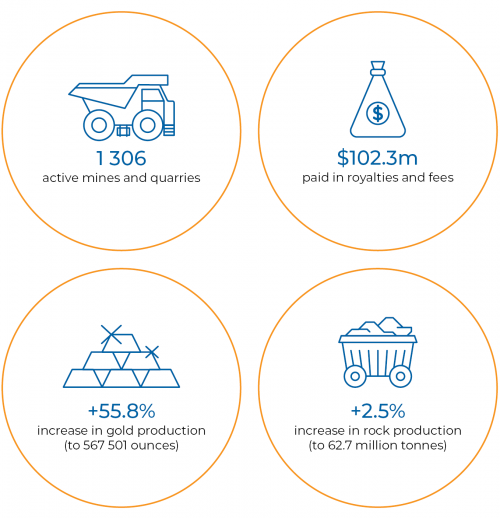
Source: VAGO, based on ERR’s 2018–19 Annual Statistical Report.
1.3 Environmental impacts
While mining brings many economic benefits, there are also downsides. In Victoria, some mining activities have resulted in severe impacts on and around the disturbed land, posing environmental, economic and safety risks to the community.
Latrobe Valley mine fire
The Latrobe Valley is home to three open-cut brown coal mines. Open-cut coal mines are particularly vulnerable to fire that spreads quickly and is difficult to extinguish.
On 9 February 2014, a fire started in the Hazelwood mine in the Latrobe Valley, and burned for 45 days. The fire caused significant environmental damage around the mine, with smoke and ash blanketing the sky for over a month. Residents experienced adverse health effects and local businesses suffered financial impacts over the fire period.
The 2014 Hazelwood Mine Fire Inquiry Report found that although it is impossible to quantify the full cost of the fire, the total cost borne by the Victorian Government, the local community and the operator of Hazelwood mine exceeded $100 million.
Risk from tailings
Tailings are waste mineral, stone or other materials left over after separating the desired mineral product from a natural rock or sediment. Tailings often consist of fine particles that have the potential to damage the environment by releasing toxic metals and contaminating soil and water supplies.
The high-risk contaminants in tailings include:
- arsenic—this naturally occurring compound is found in rock and is extremely toxic to humans, wildlife and vegetation. Gold mine tailings can hold high levels of arsenic due to the similar solubility of arsenic and gold in the ore forming fluids
- mercury—this binds to organic particles and is easily transformed into stable and highly toxic methylmercury. In this form, it can contaminate rivers and other waterways.
Other risk to groundwater and waterways
Contamination of groundwater and surface water systems by acidic water, heavy metals and other chemicals can occur when:
- tailings are discarded or a tailing dam leaches
- exposed sulphur-bearing rocks in open pit mines or underground workings oxidise and cause acid mine drainage
- water and oxygen come into contact with exposed mineralised rocks, generating water pollution
- there is other leaching from a processing plant site.
Ground movements induced by mining
Extraction activities, groundwater pressures and wall instability in open-cut mines and quarries may induce ground movements that lead to visible cracks on roads, ground surfaces and building walls.
In 2011, heavy rainfall triggered movements in the area surrounding the Latrobe Valley’s Hazelwood mine. Cracks appeared in an area near the Princes Highway and immediately north of the mine. As a result, the Princes Highway was closed for more than seven months.
In 2007, the north-east face of the Yallourn mine’s 80-metre-high wall collapsed, sliding 250 meters across the open-cut mine floor. The collapse took with it six million cubic meters of coal and earth, a mine road and two major conveyor belts.
1.4 The mining life cycle
A mine’s life cycle typically runs from pre-competitive geoscience exploration to post closure management. Figure 1C shows a mine life cycle.
FIGURE 1C: Mine life cycle
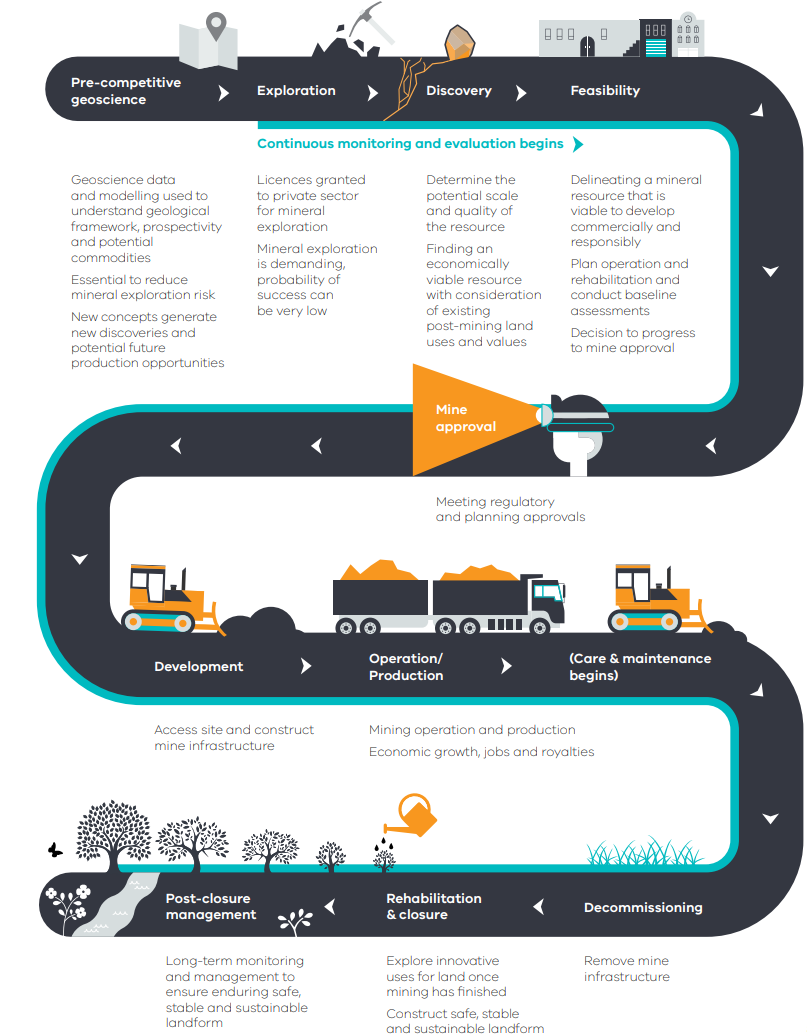
Source: DJPR’s State of Discovery: Mineral Resources Strategy 2018–2023.
Status of mines and quarries
Mining licences provide rights to explore for and extract the minerals in the land and may authorise the construction of facilities associated with the mine. A work authority permits the holder to carry out quarrying activities. ERR describes mining licences and work authorities as tenements.
Figure 1D shows the main characteristics of the four states of tenements: active, inactive, abandoned and legacy.
FIGURE 1D: Characteristics of active, inactive, abandoned and legacy tenements
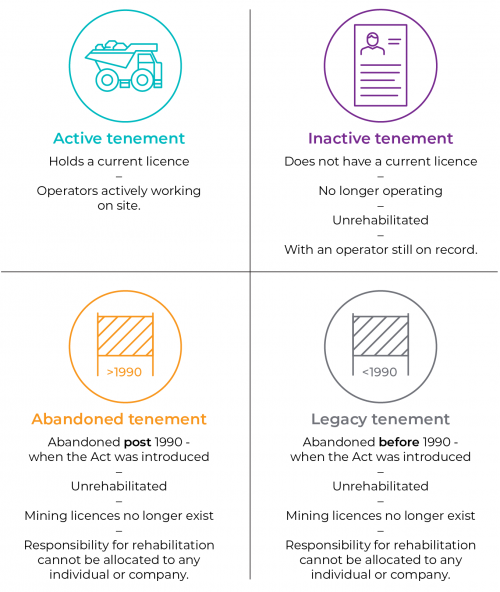
Source: VAGO.
1.5 Rehabilitating mines and quarries
The possibility of serious impact to the environment, people, land and infrastructure means it is vital to ensure mining operators fulfil their obligation to rehabilitate the land. This means returning land that has been disturbed to a safe, stable and sustainable condition.
Although the Act does not define rehabilitation, where applicable, it requires a rehabilitation plan to address:
- concepts for end utilisation of the site
- proposals for progressive rehabilitation and stabilisation of extraction areas, road cuttings and waste dumps
- any proposals for end rehabilitation of the site, including final security of the site and removal of plant and equipment.
Roles and responsibilities
Rehabilitation typically aims to:
The Australian Leading Practice Sustainable Development Program for the Mining Industry 2016 specifies rehabilitation as ‘the design and construction of landforms as well as the establishment of sustainable ecosystems or alternative vegetation, depending upon desired post-operational land use’.
- make the site safe and stable, ensuring the site does not pose a future environmental risk
- create a landscape that supports future land uses.
Earth Resources Regulation
While operators are required to rehabilitate the areas they have mined, the state may have to take on rehabilitation liabilities if an operator defaults. It is ERR’s responsibility to make sure the state does not end up with this liability.
ERR is responsible for approving mining licences and work authorities, authorising work plans and rehabilitation plans, setting and reviewing rehabilitation bonds, monitoring rehabilitation activities and returning the bond to the operator post rehabilitation.
In 2019, ERR completed its Assignment of Rehabilitation Responsibilities. Figure 1E summarises this.
FIGURE 1E: ERR’s Assignment of Rehabilitation Responsibilities
| Business unit | Role | Key responsibility |
|---|---|---|
| Regulatory Governance | Develop rehabilitation framework, strategies, policies and procedures | Manage rehabilitation improvement projects Develop rehabilitation framework (life cycle model and strategy) Develop/maintain operational policies (e.g. risk appetite framework for setting bonds |
| Assessment | Specify site rehabilitation requirements | Assess and approve/refuse rehabilitation plans Provide guidance to applicants on: (1) the preparation of rehabilitation plans; (2) onsite rehabilitation requirements Provide advice to Rehabilitation Liability Assessment and Bonds Team |
| Rehabilitation liability assessment and bonds | Assess site rehabilitation liabilities and set bonds | Update/maintain bond calculator Develop methodology and calculate the state’s contingent liabilities for site rehabilitation Prepare guidelines on the preparation of rehabilitation liability self-assessments Issue notices requiring: (1) initial liability assessments and bonds; (2) updated liability assessments and further bonds Authorise return of bonds Provide advice to Assessments Team on: (1) preparation of rehabilitation plan guidelines; (2) potential liabilities associated with proposed rehabilitation plans, including options to minimise liability risks |
| Technical services | Inform rehabilitation requirements and liabilities | Provide technical advice to Assessments Team on: (1) common risks/controls relating to site rehabilitation plans; (2) key risks/controls for specific sites relating to rehabilitation plans (such as geotechnical stability and groundwater factors) Provide technical advice to Rehabilitation Liability Assessment and Bonds Team on: (1) rehabilitation liability assessments for specific sites; (2) any residual technical issues post rehabilitation |
| Regulatory compliance | Ensure operators complete rehabilitation works | Provide field-based knowledge to inform the Assessments and Rehabilitation Liability Assessment and Bonds teams, as relevant Ensure operators’ compliance with approved rehabilitation plans, including issuing notices directing works and conducting investigations into alleged breaches |
| Licencing | Assess fit and proper status and provide administrative support | Register bonds Manage bond transfers and surrenders Return bonds on authorisation of completed works by Rehabilitation Liability Assessment and Bonds Team |
| Business management | Administer financial requirement | Manage storage of rehabilitation bonds Manage bond call-in process |
| Stakeholder and community engagement | Let people know what ERR is doing to improve site rehabilitation
|
Disseminate materials to stakeholders Coordinate responses to public inquiries |
Source: VAGO, based on ERR documentation.
Rehabilitation plans
Under the Act, an operator proposing to do work under a mining, prospecting or exploration licence must include a rehabilitation plan in its work plan application.
Since 2013, the Act has required varying levels of information on rehabilitation for each of the four mining licences.
The Act also requires a prospective quarry operator to submit a rehabilitation plan before obtaining a work authority.
The level of detail required in rehabilitation plans has changed over the years as the Act and regulations have been amended. In general, the Act requires rehabilitation plans to account for:
- the surrounding environment
- the need to stabilise the land
- any potential long-term degradation of the environment.
Rehabilitation bonds
Rehabilitating sites can be a long and expensive process. Because of this, the Act requires operators to provide a rehabilitation bond as financial security before commencing work. This is to ensure the state can rehabilitate the site should the operator default.
A rehabilitation bond is calculated to cover the full amount required to achieve the final rehabilitation outcome as specified in the rehabilitation plan.
Forms of security
Operators provide rehabilitation bonds in the form of unconditional bank guarantees by way of a letter of credit from a banking institution. However, the 2019 Rehabilitation Bond Policy for the Latrobe Valley Coal Mines provides that specifically for the Latrobe Valley mines, the Minister may consider bonds in a hybrid form—where the bank guarantee is complemented by a security in the form of a parent company guarantee.
A bank guarantee ensures that the liability of a debtor will be paid if the debtor fails to settle a debt.
From December 2015, licence and work authority holders were able to pay a cash bond if the assessed rehabilitation liability was $20 000 or less.
Bond consultation process
The Minister for Resources determines the amount of a rehabilitation bond. However, under the Act, the Minister must consult with the local municipal council and landowner, where relevant, for both mining and quarrying. ERR does this on behalf of the Minister.
Figure 1F shows a consultation matrix for bond management.
FIGURE 1F: Bond Management Consultation Matrix
| Exploration licence | Mining licence | Work authority | |||||
| Crown land | Private land | Crown land | Private land | Crown land | Private land | ||
| Bond setting | LM | LM | Owner Council |
LM | Council | ||
| Bond review | LM Licensee |
LM Licensee |
Owner Council Licensee |
LM Work authority holder |
Work authority holder | ||
| Bond return | LM | Owner | LM | Owner Council |
LM | Owner Council |
|
Note: LM refers to the Crown land manager responsible for managing the Crown land area.
Source: Bond Policy.
Bond reviews
The Bond Policy requires that ERR periodically review bonds during the life and towards the end of operations. This is to assess whether the current bonds reflect the cost required to deliver final rehabilitation.
The Bond Policy also provides ERR guidance on the frequency and timing of bond reviews per a risk-based schedule as set out in Figure 1G.
FIGURE 1G: Recommended frequency of bond reviews
| Consequences | Likelihood | |||
| HIGH | MEDIUM | LOW | NEGLIGIBLE | |
| HIGH | 2 years e.g. large mining licence—Gold |
3 years e.g. large mining licence—other metals, mineral sands |
6 years e.g. large mining licence—non-metallic (other than coal for power generation) |
10 years Coal (major power generation) |
| MEDIUM | 3 years e.g. small mining licence—Gold small mining licence—other metals |
6 years e.g. work authority—regional significance |
10 years e.g. work authority—state significance |
10 years |
| LOW | 7 years e.g. small mining licence—non-metallic |
10 years e.g. work authority—local significance |
10 years | 10 years |
Source: Bond Policy.
Rehabilitation-specific risk assessment framework
ERR’s 2019 Rehabilitation Bond Review Operational Policy provides for rehabilitation-specific risk criteria which consider the:
- likelihood of the operator defaulting on rehabilitation responsibilities and therefore the rehabilitation bond being called in
- risk that the value of the bond is inadequate to rehabilitate the sites.
Assessment criteria falls into two groups:
|
Rehabilitation risk assessment factors may be... |
For example... |
|
Primary |
Estimated bond shortfall |
|
Secondary |
Alignment between the rehabilitation plan and likely rehabilitation requirements |
This is ERR’s first framework that directly considers rehabilitation-specific risks of Victorian mines and quarries.
Return of bonds
ERR returns a bond once the land has been rehabilitated to a satisfactory level, as determined by the Minister for Resources, following the completion of a rehabilitation assessment report and the required consultation process.
Stages of rehabilitation
There are two key parts to rehabilitation—progressive activities and the final activities. Prior to final rehabilitation, operators may undertake interim rehabilitation works to manage hazards such as fire and ground erosion.
ERR plays an important role in making sure that rehabilitation is properly undertaken, beginning from the approval of a mining licence. This includes monitoring progressive rehabilitation activities, reviewing rehabilitation bonds, assessing final rehabilitation outcomes and returning rehabilitation bonds.
Figure 1H gives an overview of ERR’s role in managing mining rehabilitation.
FIGURE 1H: ERR's roles
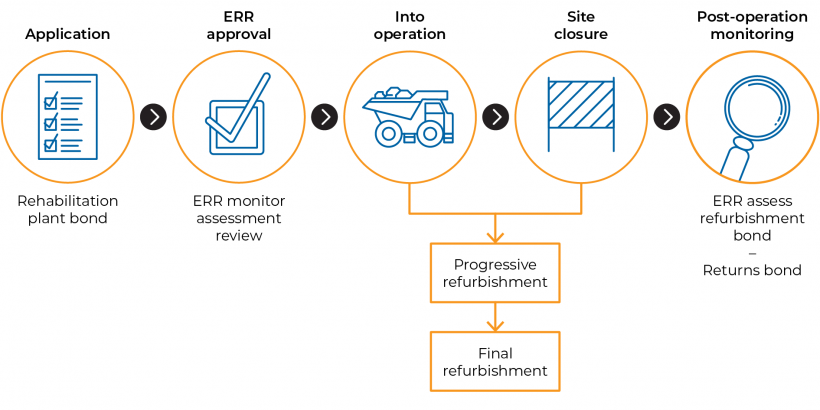
Note: *For mining licences, bonds may be lodged after licence approval but before operations start.
Source: VAGO.
Progressive rehabilitation
Since the introduction of the Mineral Resources (Titles) Regulations 1991, the Act and its regulations have required operators to include progressive rehabilitation proposals in their mining rehabilitation plans.
Progressive rehabilitation should consider the timing, sequence of and benchmarks for the rehabilitation works. These include but are not limited to:
- native vegetation
- productivity of rehabilitated agriculutral land
- final slopes of pits
- tailing dams.
The progressive plan may cover the life of the licence or a shorter period, with updates required in the later stages of a mine’s or quarry’s life cycle.
Final rehabilitation
Final rehabilitation occurs after mining or quarrying operation ceases and prior to site closure and its return to the landowner. The operator undertakes work to rehabilitate the land to a safe, stable and sustainable form for future land use.
1.6 Legislative framework and other policies
The Minister for Resources directly delegates their regulatory power to the ERR Executive Director and other senior staff in ERR.
Legislation and regulations
Mineral Resources (Sustainable Development) Act 1990
The Act is the primary legislation for regulating mineral and the extractive resources sector.
The Act aims to:
- encourage and facilitate exploration for minerals
- establish a legal framework to ensure risks posed to the environment and the public are minimised as far as reasonably practicable.
Mineral Resources (Sustainable Development) (Mineral Industries) Regulations 2019
The MRSDMIR was the first regulation introduced in Parliament that regulates the mineral resources sector under the Act. It has had subsequent amendments over the years and the new requirements for rehabilitation plans took effect on 1 July 2020.
Environment Protection Act 2017
The Environment Protection Act 2017 (as amended) establishes EPA and provides the foundation to protect Victoria’s environment. It also set EPA as a mandatory referral authority for mining work plan applications and variations, where a planning permit is required, from 1 July 2019.
Ministerial Statement of Expectations
The Minister for Resources’ Statement of Expectations 2018–20 outlines key areas of governance and operational performance that ERR should work on to reduce regulatory burden and improve its regulatory practice.
None of the Minister’s 14 specific expectations in the statement relate directly to rehabilitation. The focus is to implement the recommendations of the Commissioner for Better Regulation’s 2017 Getting the groundwork right: Better regulation of mines and quarries, which was triggered by perceived delays and uncertainties in ERR’s approval processes.
In September 2018, DJPR committed to implementing the 14 specific expectations.
Mineral Resources Strategy
The Victorian Government developed the Mineral Resources Strategy 2018–2023 to help grow investment and jobs in Victoria’s minerals sector by:
- building community confidence in social, environmental and economic performance of mineral exploration and development
- improving the state’s attractiveness for minerals investment
- strengthening the state’s position as a global mining and mining services centre.
Extractive Resources Strategy
The government developed the 2018 Extractive Resources Strategy to ensure that high-quality extractive resources continue to be available at a competitive price to support the state’s growth. Its objectives include:
- providing secure and long-term access to extractive resource areas of strategic importance to the state
- maintaining and improving Victoria’s competitiveness and providing greater certainty for investors in the extractives sector
- encouraging leading-practice approaches to sustainability, environmental management and community engagement.
The Bond Policy
The Bond Policy s provides that ERR is responsible for setting, reviewing and returning the rehabilitation bonds for mines and quarries in Victoria.
Regulatory Practice Strategy for the Rehabilitation of Earth Resources Sites
In February 2020, ERR released the Regulatory Practice Strategy for the Rehabilitation of Earth Resources Sites, which outlines the approach and actions underway to improve how it plans and manages rehabilitation of mines and quarries over their life cycle.
It sets out the strategic objectives of:
- protecting people, land, infrastructure and the environment
- ensuring land can be returned to a safe, stable and sustainable landform
- minimising the state’s exposure to rehabilitation liabilities
- being a best-practice regulator.
1.7 Relevant agencies
Figure 1I lists relevant agencies’ responsibilities.
Figure 1I: Mining rehabilitation responsibilities
| Agency | Responsibility |
|---|---|
| DJPR (ERR) | Administers the Act and the MRSDMIR, including approving rehabilitation plans, monitoring and enforcing operators’ compliance with mining rehabilitation responsibilities, and setting, reviewing and releasing rehabilitation bonds. |
| EPA |
Regulates offsite discharges of water from earth resources sites. Sets discharge standards that ERR requires operators to comply with. Approves licensing for landfills and other regulated waste facilities when not regulated by the Act. A mandatory referral authority for mining and quarrying work plans, and variations, where a planning permit is required—which includes rehabilitation plans. Participates in Environment Effect Statement process by providing technical expertise to relevant decision makers. Other than as indicated above, EPA has no direct role in managing/regulating/commenting on rehabilitation works. However:
|
| DELWP |
Manages land use planning and environmental assessments in the state. As a referral authority, DELWP comments on work plans including rehabilitation plans and manages legacy/historic sites on Crown land. In general, has no direct role in managing/regulating/commenting on rehabilitation works. Exceptions include:
|
| Catchment Management Authorities |
Manage regional waterways, floodplains, drainage and environmental water reserves under the Water Act 1989. They are also referral authorities for mining and quarrying work plans when proposed land involves floodplains. In general, they have no direct role in managing/regulating/commenting on rehabilitation works. |
| LVMRC | LVMRC was established in May 2017 as a statutory office to monitor and audit Latrobe Valley mine rehabilitation. Although the audit scope excludes the regulation of the Latrobe Valley coal mines, as DJPR and DELWP were developing the Latrobe Valley Regional Rehabilitation Strategy(a) during the audit, we consulted LVMRC(b) on the current rehabilitation regulatory practice. |
Note: (a) The Minister for Resources released the Latrobe Valley Regional Rehabilitation Strategy on 26 June 2020.
Note: (b) The new Mine Land Rehabilitation Authority superseded the roles and functions of the LVMRC on 30 June 2020.
Source: VAGO, based on ERR Compliance Strategy 2018─20, and the Environment Protection Act 2017 (as amended), Planning and Environment Act.
2. Rehabilitation liabilities
Conclusion
ERR has not effectively regulated rehabilitation bonds, meaning the state is financially exposed to significant costs for site rehabilitation. The amount ERR holds in bonds is likely to be at least $361 million short of the estimated cost of rehabilitating Victoria’s existing mines and quarries.
ERR cannot demonstrate that it ensures sites have been rehabilitated, as required, before returning the bond to operators. This includes ensuring that the state has no remaining liability.
This chapter discusses:
2.1 Overview
Rehabilitation bonds ensure that the government has sufficient funds to rehabilitate mine and quarry sites if operators do not or are unable to do so.
ERR’s Bond Policy explains that rehabilitation bonds are calculated to fully cover rehabilitation costs. As such, rehabilitation bonds ensure that:
- rehabilitation costs do not fall to Victorian taxpayers
- mines and quarry sites are appropriately rehabilitated and closed.
2.2 Rehabilitation bonds
Current rehabilitation bonds held by ERR
Available ERR data suggests that as at December 2019, ERR holds $813 million in rehabilitation bonds for 1 394 mines and quarries across Victoria.
The bonds for the three coal mines in the Latrobe Valley account for $591 million, or nearly 75 per cent, of the total. The remaining $222 million secures the remaining 1 391 mines and quarries across the state.
Difference between bonds held and actual rehabilitation liability
Actual rehabilitation liabilities for Victoria’s mine and quarry sites are considerably higher than what is held in these bonds. It is not clear exactly how much more.
ERR’s preliminary assessment in November 2019 suggests that there is a shortfall of at least $361 million. Figure 2A illustrates this.
FIGURE 2A: Rehabilitation bonds and rehabilitation liabilities
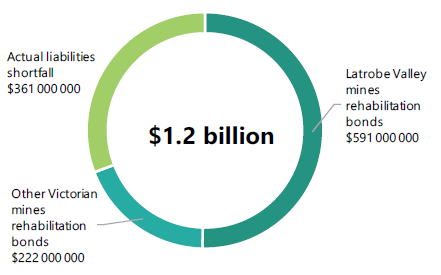
Source: VAGO.
ERR advised us, however, that this preliminary estimate is only intended for scoping and planning future regulatory actions and should not be considered as an accurate estimate of actual rehabilitation liabilities. ERR further advised that this estimate is an initial assessment and that it will conduct further reviews to accurately determine total rehabilitation costs.
Low estimate
$361 million is a low estimate.
ERR’s determination of the rehabilitation liabilities for some of the sites was informed by various factors including the operators’ self-assessment of actual liabilities. However, for most of the 1 394 mines and quarries, ERR acknowledges that its assessment was completed largely as a desktop analysis. It applied:
- $10 000 as the estimated rehabilitation cost for mines and quarries having less than $10 000 in rehabilitation bonds (over 500 sites)
- a modest 10 per cent increase in rehabilitation cost for sites with bonds of at least $10 000 (over 800 sites).
Prior to this assessment, ERR had not attempted to determine the liability. This is ERR’s first serious effort to estimate the difference between the rehabilitation bonds it holds and the actual rehabilitation liability for mines and quarries across the state.
ERR advised us that it will conduct further reviews to accurately determine total rehabilitation costs. However, it is not clear whether ERR will do site inspections or require further evidence from operators to achieve this. It is also not clear when ERR will conduct these reviews.
Low-value rehabilitation bonds
According to available ERR data, as shown in Figure 2B, 1 239 mines and quarries have rehabilitation bonds above $0 and below $200 000. For 526 of these (covered by mining licences and work authorities), the bond value is $10 000 or less.
This is not sufficient to cover rehabilitation costs.
FIGURE 2B: Rehabilitation bonds by value range as at December 2019
| $500K | $200K–500K | Under $200K | No bond—$0 | No bond on record |
|---|---|---|---|---|
| 65 | 52 | 1 239 | 36 | 2 |
Source: VAGO, based on ERR documents.
ERR’s Bond Policy provides a standard bond rate of $4 000 per hectare for small and low-risk quarries. It defines these as being less than five hectares in area and less than five metres in depth, and not requiring blasting or native vegetation clearance.
Small and low-risk quarries are operated under ERR’s Code of Practice and as such are not subject to all the requirements of the Act. For example, because of their relatively low rehabilitation risk, a rehabilitation plan is not required. Their operators, however, still need to rehabilitate the site post operation.
However, we identified, in ERR’s data listing:
- 224 sites of five hectares or less, with rehabilitation bonds less than $4 000 per hectare
- 275 sites of greater than five hectares, with rehabilitation bonds less than $4 000 per hectare. Within this group, there are 100-hectare gold mines.
Given $4 000 per hectare is considered necessary for small, low-risk operations, it is unlikely that a lesser value represents a suitable rehabilitation bond rate for larger and more complex sites.
ERR contests this comparison and maintains that for mine and quarry sites larger than five hectares, the $4 000 per hectare rate should only be applied to the disturbed area and not the entire site.
We requested data on the disturbed area for these 526 mines and quarries. ERR was able to provide information for 11. For six of these sites, considering the size of the disturbed area only, the rehabilitation bonds significantly fell short of $4 000 per hectare, while the remaining five only just met the standard rate.
Rehabilitation bonds are meant to ensure that the state has funds to restore sites if operators do not. The fact that many sites have bonds that are less than what is deemed enough for basic quarry operations means that the state is potentially exposed to significant financial risk.
Mines and quarries with no rehabilitation bonds
The Act requires an authority holder to enter a rehabilitation bond sufficient to cover full rehabilitation costs before commencing operations:
- For mining licence holders, the bond needs to be lodged prior to carrying out any work on the land.
- For quarry operators, a bond needs to be in place before ERR grants a work authority.
When we reviewed ERR’s data on mining licences and work authorities, we identified 578 mines and quarries with no rehabilitation bond noted:
- 24 sites, we were able to confirm are operating and therefore should have bonds in place.
- 14 sites have licences or work authorities that are no longer valid but are yet to be rehabilitated, and therefore should have bonds in place.
- 168 mines according to ERR have not started ground operations and therefore do not require bonds. However, ERR was unable to provide documentation to support this claim.
- 372 mines and quarries according to ERR have had their bonds either returned to operators or called in for rehabilitation works. However, ERR was unable to provide documentation to support this claim.
ERR acknowledges that limitations in its record keeping and information management systems mean it cannot assure that these sites do not require rehabilitation bonds.
ERR is in breach of its regulatory responsibility to ensure that mines and quarries have rehabilitation bonds as required by the Act.
2.3 Contingent liability
If operators default on their obligation to rehabilitate their site, the state may be liable to do this.
DJPR’s reported contingent liability
DJPR’s 2018–19 Annual Report recorded a $29.8 million state government CL for mining site rehabilitation.
How CL is calculated
To estimate the state’s CL for mining rehabilitation, ERR used its rehabilitation risk assessment framework. This is the first time ERR has developed and implemented a risk assessment framework specific to rehabilitation liabilities. Section 2.4 further discusses the framework. ERR calculated the state’s $29.8 million CL as shown in Figure 2C.
FIGURE 2C: Calculating CL

Source: VAGO.
Figure 2D shows DJPR’s reported mining rehabilitation CL since 2015–16.
FIGURE 2D: Mining rehabilitation contingent liabilities reported by DJPR
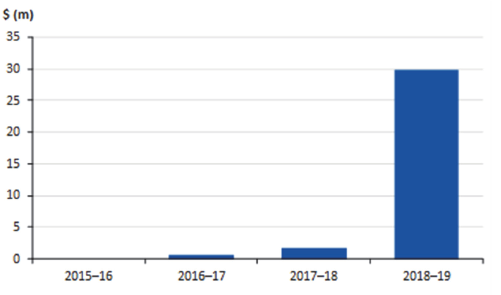
Source: VAGO, based on DJPR annual reports.
It is unclear why the amount of CL reported was $0 as at 30 June 2016. The then DEDJTR’s 2015–16 Annual Report did not explain this.
Low CL estimate
The $29.8 million CL reported in 2018–19 is significantly higher than the $1.7 million that the then DJPR reported in its 2017–18 Annual Report.
This difference is not due to increased risks in 2018–19, but rather to ERR’s previous lack of rigour in determining the state’s potential rehabilitation liability.
ERR acknowledges that the $29.8 million figure is still an underestimate. As at November 2019, ERR advised that the state’s CL could be $50 million for all Victorian earth resources sites.
It is expected that DJPR will again report on the state’s mining CL in its 2019–20 annual report.
ERR’s plan to better calculate CL
ERR advised that it will review its assessment of the state’s CL against a number of risk factors, including:
- the difference between current rehabilitation bond values and estimated actual rehabilitation liability
- public, land, infrastructure and environmental risks at each site
- the operator’s financial position.
ERR is yet to determine the timeline for completing this as it is subject to resourcing.
2.4 Regulating bonds
Setting the rehabilitation bond
ERR’s process of setting rehabilitation bonds does not ensure the calculated bond value covers the full cost of rehabilitation.
Rehabilitation bond calculator
ERR’s March 2019 internal audit identified limitations in its rehabilitation bond calculator.
|
ERR's bond calculator... |
For example... |
|
is outdated—it was last updated in September 2010 |
input rates have not been adjusted to reflect changes to the consumer price index, which has increased by 19.8 per cent (2019) since 2010. |
|
does not take into consideration factors that affect rehabilitation costs |
it does not take into account the remoteness of sites and operations in areas of high environmental sensitivity. |
|
cannot be adequately tailored for varying operations—a single calculator is used for all types of operations |
the calculator does not have inputs for extractive industries that require specific rehabilitation techniques. |
Our consultation with industry stakeholders and ERR staff confirmed these issues remain.
ERR is now revising its calculator. It commissioned a specialist service provider to inform the required changes with this work including a comparative analysis of the bond calculators used in New South Wales and Queensland.
ERR advised that it was on track to release the updated bond calculator by December 2020 but due to the economic uncertainty caused by the COVID-19 pandemic, it has postponed its March 2020 stakeholder consultations. This might mean that ERR will not meet its planned timeline for the release of the calculator.
Bond setting consultation
The Act and regulations require ERR to consult councils and DELWP, as Crown land manager, when setting the initial value of rehabilitation bonds. We reviewed a random selection of 10 mineral licences and work authorities with mixed risk ratings.
Two files had no recorded evidence that ERR undertook the necessary consultation to inform their bond setting. In the other eight instances, consultation did take place, but the stakeholders’ input does not appear to have been useful in setting bonds.
ERR is not obtaining the information needed from bond setting consultations because:
- most council officers do not have the technical skills to provide meaningful comments on rehabilitation bonds
- ERR does not guide councils on what they need to consider in the bond setting process
- DELWP’s regional officers are often not presented with sufficient information on proposed rehabilitation works, potential environmental impacts and related rehabilitation costs to allow them to properly contribute.
This means that while ERR generally complies with consultation requirements, councils and DELWP are not always able to provide meaningful input because of the lack of guidance and information from ERR. Without this, ERR may not fully identify rehabilitation costs and therefore not accurately value the bonds.
Returned rehabilitation bonds
There is only a limited auditable trail of documentation to show that, prior to refunding bonds, ERR satisfies itself that operators have completed rehabilitation as per their rehabilitation plans.
ERR has an established procedure before returning bonds. It requires:
- inspection of the site
- completion of a rehabilitation assessment report
- consultation with the landowner and council where appropriate.
However, inconsistent application of the procedure and limitations in its record keeping means that ERR is unable to provide assurance that, where it has returned a bond, it ensured the operators had met rehabilitation requirements in all cases.
While we saw some field entry reports resulting from inspection of some sites, these provide varying levels of detail, and did not cover all the issues required to be addressed in a rehabilitation assessment report including:
- earthworks or final landform
- run off and erosion control
- tailings dam, water dams, slimes dams
- site safety
- maintenance and monitoring
- site-specific criteria (including work plan requirements).
This means that even though ERR complies with the requirement to consult with the landowner, council and the Crown land manager, where appropriate, it cannot assure that these sites have been rehabilitated as required, and that the state therefore has no remaining liability.
Rehabilitation certification
The Act allows ERR, as the Minister for Resources’ delegate, to require authority holders to provide certification from an auditor that they have rehabilitated the land as per the rehabilitation plan. However, ERR’s Bond Policy does not provide for this option. This is a missed opportunity for the state to place the cost of assessment on the operator instead of the state.
Bond reviews
The Act states that the Minister for Resources may require an authority holder to provide an additional rehabilitation bond if they believe the prior bond to be insufficient. The Bond Policy supports this provision and requires ERR to review rehabilitation bonds regularly and ensure that it holds sufficient funds to meet potential rehabilitation expenses.
The Bond Policy also provides the frequency and timing of bond reviews as set out in Figure 1G.
Rehabilitation bonds not reviewed
ERR has not reviewed bonds in accordance with its Bond Policy.
Available ERR data, as indicated in Figure 2E, shows that:
- ERR is on track, as required by the Bond Policy, with its review of 116 (8.3 per cent) of rehabilitation bonds
- 91.7 per cent (1 278) are not on track, of which:
- 68.6 per cent (956) are overdue for review, by up to 23 years or nine years on average
- 23.1 per cent (322) do not have a next review scheduled. ERR records suggest that nearly half of these have not been reviewed since their licences and work authorities were first granted between 1988 and 2015.
FIGURE 2E: ERR reporting of rehabilitation bonds reviews as at 6 December 2019
| On track | Overdue | Next review date not recorded | Total |
|---|---|---|---|
| 116 | 956 | 322 | 1 394 |
Source: VAGO, based on ERR documents.
While ERR has reviewed the bonds for the Latrobe Valley coal mines following the findings of the 2016 Hazelwood Mine Fire Inquiry Report Volume IV—Mine Rehabilitation, the rehabilitations bonds for most mines and quarries across the state have not been reviewed in accordance with the Bond Policy.
This means that ERR cannot give assurance that bond values reflect what it would cost to undertake rehabilitation works if an operator defaults.
Rehabilitation risk analysis
Prior to developing its 2019 rehabilitation-specific risk assessment framework, ERR acknowledges that its various risk assessments did not consider or address rehabilitation issues. This means that ERR’s bond reviews included in Figure 2F were not risk-based in terms of rehabilitation-specific issues.
As at December 2019, ERR has assessed the rehabilitation risk of 112 mines and quarries, or less than 8 per cent of Victorian mines and quarries.
Comparing this assessment with the bond review status of these mines and quarries, ERR is not on track in reviewing the bonds of 15 of 17 sites that ERR evaluated as high-risk for rehabilitation issues.
Bond review moratorium
ERR acknowledges that a moratorium was in place for rehabilitation bond reviews from 2013 to 2017, but was unable to provide documentary evidence about its:
- approval in 2013
- announcement to ERR staff, mine and quarry operators and stakeholders
- guidance to staff on its implementation
- termination in 2017.
Our stakeholder consultation suggests that the mining industry understood that the moratorium was set because ERR was about to endorse a new bond policy. However, when the draft policy was not endorsed, ERR did not announce the moratorium’s termination.
The stakeholders’ account of the moratorium is consistent with ERR’s March 2019 internal audit report, which stated that because ERR could not provide documentary evidence on the lifting of the moratorium, it is unclear whether ERR advised its staff and the industry about it.
The internal audit report also said that staff in some ERR regional offices were unclear on whether the moratorium was still in place at the time of the internal audit. As late as September 2019, ERR staff we spoke to were unclear about the status of the moratorium.
ERR advised that in response to the 2019 internal audit:
- its May 2019 newsletter to stakeholders stated, ‘we continue to assess site rehabilitation requirements, and review and set bonds across the state’. It reiterated this message to stakeholders at a meeting in August 2019. ERR also distributed the newsletter to staff across ERR offices.
- ERR informed staff about the assignment of rehabilitation roles and responsibilities—including the continuation of bond reviews—during ERR staff meetings in 2019
- ERR’s Executive Director emailed all ERR staff in October 2019 to clarify that no moratorium was in place and therefore they should undertake bond reviews in accordance with the Act.
Impact of the moratorium on the number of bond reviews
Figure 2F shows that the number of bond reviews started declining in 2011–12 but dropped significantly from 2013–14 to 2014–15, when the moratorium took effect.
The 2016–17 and 2017–18 figures are 70 and 60 per cent lower than the pre moratorium year of 2012–13.
However, ERR did revise some bonds during this time, for example, for the three Latrobe Valley coal mines as well as directing a mining licence holder to increase its rehabilitation bond by $100 000 in February 2016 and again by $527 665 in May 2019.
FIGURE 2F: Bonds reviewed by ERR
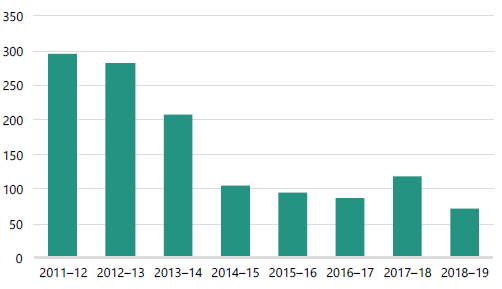
Note: The 2018–19 figure is derived from ERR’s 2018–19 Statistical Report, and the rest is counted from ERR’s bond review spreadsheet.
Source: VAGO, based on ERR documents.
The moratorium is not consistent with the Bond Policy’s requirement that ERR periodically review rehabilitation bonds.
The lack of documentation to demonstrate when, why and by whom the moratorium was approved or lifted breaches principles of transparency and accountability.
Clear documentation of the rationale and approval process is important, as the decision clearly benefited mine and quarry operators, potentially to the detriment of the environmental protections that are intended by the regulations.
2.5 Issues of conflict of interest
DJPR as promoter and regulator
The Act requires DJPR to facilitate exploration for minerals and foster mining operations, while also protecting the environment from the potential adverse impacts of mining.
The 2016 parliamentary Independent Inquiry into the EPA raised concerns about the conflict of interest in having ERR—the primary mining regulator—as a unit within DJPR, the department responsible for fostering and developing the mining industry.
It noted that ERR has not regulated the environmental and public health risks associated with mining operations to the same level as other regulators have for industries with similar environmental risk profiles.
ERR’s position on conflict of interest issues
Invest Victoria is the state’s investment attraction agency, fostering economic growth by enabling business investments and job creation.
ERR acknowledges its historical poor performance in regulating rehabilitation but said that Invest Victoria’s transfer to the Department of Treasury and Finance in January 2019 demonstrates the removal of responsibilities for fostering and developing major investments, including on mining, from DJPR.
RR also notes that another DJPR business unit—in the same branch as ERR— facilitates investments in resources and identifies opportunities for the state’s earth resources sector. However, it contends that as decision-making on mining and quarrying approvals and regulation resides within ERR—as delegated by the Minister for Resources—this isolates it from other areas of DJPR that promote and advocate for mining and quarrying projects.
However, having these two units—one attracting and facilitating investment in mining and quarrying, and the other regulating the sector—in the same branch and reporting to the same branch head means that the necessary separation has not been achieved.
ERR needs to demonstrate that it can effectively discharge its regulatory functions by appropriately balancing:
- its commitment to the Minister for Resources’ Statement of Expectations 2018–20 and the Commissioner for Better Regulation’s Getting the Groundwork Right to reduce the regulatory burden on operators by facilitating and streamlining approval and regulatory processes
- giving effect to the objective of the Act to ensure that risks posed to the environment are identified and eliminated or minimised.
Recent amendment to the Act
To address concerns about conflict of interest, the Independent Inquiry into the EPA recommended that EPA play a greater role in mining regulation. The government supported this recommendation in principle and amended the Act to mandatorily refer mining work plan applications, including rehabilitation plans, to EPA from 1 July 2019.
As laid out in Figure 2G, the government did not support the full implementation of most of the inquiry’s recommendations.
FIGURE 2G: Government’s response to EPA Inquiry recommendations
| EPA Inquiry recommendation | Government response - Support in principle |
|---|---|
| EPA to advise on environmental considerations with respect to all mining licence applications, renewals and extensions, including on setting of bonds and environmental conditions | EPA role limited to review of work plans, with no role in licence renewals and extensions. EPA’s role in bond setting limited to high-risk mines |
| ERR to refer mining and quarrying work plan applications and variations to EPA, including rehabilitation plans | Agreed |
| EPA to be responsible for compliance and enforcement of the environmental conditions in the mining licence | Limited role—EPA will use existing powers to inspect mining sites relative to pollution events |
| EPA to be responsible for compliance and enforcement of care and maintenance conditions for inactive but still licensed mines | Limited role—EPA will use existing responsibility over pollution events and onsite contamination |
| EPA to be responsible for compliance and enforcement of environmental elements of rehabilitation requirements in the mining licence conditions | Limited role—EPA will use existing responsibility over pollution events and onsite contamination |
| ERR to seek EPA advice on all applications for reductions in, or the return of, rehabilitation bonds | Limited role—EPA will only be consulted on high-risk mines |
Source: VAGO, based on the 2017 Government Response to the Independent Inquiry into the Environment Protection Authority.
The limited additional roles now assigned to EPA do not sufficiently mitigate the conflicts of interest that persist. This is because most regulatory responsibilities continue to lie solely within ERR, particularly the compliance with and enforcement of conditions to protect the environment.
3. Regulating rehabilitation
Conclusion
ERR’s regulation of mining rehabilitation does not meet its responsibilities under the Act, relevant regulations and policies. As a result:
- neither operators nor ERR clearly understands the outcomes that rehabilitation plans aim to achieve at mine and quarry sites, or the cost required to complete rehabilitation
- ERR is not readily aware if authority holders do not comply with their rehabilitation responsibilities.
This increases the risk of the state taking on a rehabilitation liability due to a mining operator not fulfilling their obligations as required by the Act. Until ERR conducts effective regulation, it will not be able to:
- incentivise operators’ compliance with their rehabilitation responsibilities
- limit the government’s exposure to rehabilitation liabilities.
ERR and DELWP are not strategically managing abandoned and legacy mines and quarries to reduce environmental, public health and safety risks. Neither knows the actual number of abandoned and legacy sites across the state.
This chapter discusses:
3.1 Overview
The Minister for Resources delegates to ERR the allocation of licences and work authorities for mining and quarrying, and the setting of bonds. In addition, the DJPR Secretary delegates to ERR responsibility for assessing and approving work plans and their associated rehabilitation plans.
The Act and the MRSDMIR require ERR to collect mining operators’ rehabilitation information annually through expenditure and activities reports.
As the primary regulator of the mining industry in Victoria, ERR must ensure operators comply with the requirements of the Act to:
- progressively rehabilitate mining sites during operations
- as far as practicable, complete rehabilitation before the mining licence expires.
If the operator does not complete rehabilitation before the licence or work authority finishes, the Act requires them to complete rehabilitation ‘as expeditiously as possible’. This means that it is important for ERR to regulate rehabilitation well to ensure operators fulfil their responsibilities.
3.2 Rehabilitation plans
Purpose of rehabilitation plans
Comprehensive and clear rehabilitation plans are the first step to effective rehabilitation. ERR’s Compliance Strategy 2018–2020 states that one of the objectives of ERR’s regulatory functions is to identify and manage risks to the environment and public safety. However, the rehabilitation plans we reviewed do not have sufficient detail to make this assessment.
If ERR approves rehabilitation plans that are unclear and lack detail, then the:
- state is not promoting the legislative requirement for operators to properly rehabilitate their sites
- bonds—which ERR computes based on the plan—will not cover the true cost of rehabilitating the land, potentially exposing the state to significant liabilities.
Information in rehabilitation plans
The MRSDMIR's and MRSDEIR’s information requirements for rehabilitation plans have evolved, as highlighted in Figure 3A.
FIGURE 3A: Information requirements for rehabilitation plans
| Information requirement |
|---|
From 1991
From 2012
From 2015
From 1 July 2020 for mines and 1 July 2021 for quarries
|
Note: ERR assesses and approves rehabilitation plans according to the requirements in place at the time of the plan’s submission.
Source: VAGO, based on the Act, MRSDMIR and MRSDEIR.
Since 1 November 2014, mine and quarry sites that do not exceed five hectares have not required a rehabilitation plan, provided the works do not involve underground operations, blasting, clearing of native vegetation or chemical treatments. The same applies to licensees of low-impact exploration or prospecting mine sites.
However, the 2014 Code of Practice for Low Risk Mines requires these operators to rehabilitate disturbed land as soon as practicable, and return the site to a safe, stable, and non-polluting state.
Information requirements are not retrospective
Risk-based work plans—include information about onsite risks that could impact public safety, the environment or public infrastructure; and how the applicant plans to eliminate or minimise them.
According to the Act, the requirements for rehabilitation plans are not retrospective. Operators do not have to revise their plans to conform with later and more stringent requirements, such as transitioning to risk-based plans, unless:
- they apply for a work plan variation
- their mining activity ‘poses an unacceptable risk to the environment, to any member of the public, or to land, property or infrastructure’.
ERR’s ability to direct an operator to transition to risk-based work plans is dependent on its finding of ‘unacceptable risk’ in the site’s operations. However, neither the Act nor the regulations define ‘unacceptable risk’. This means that to use this new power under the Act, ERR needs to:
- define what ‘unacceptable risk’ means
- develop a process to assess sites against this definition.
We understand that ERR has made progress in identifying high-risk mine and quarry sites and these are listed in its Compliance Strategy 2018–2020. However, it is yet to define ‘unacceptable risk.’
Review of rehabilitation plans
We assessed the rehabilitation plans for 20 tenements against the requirements in place at the time of the plan’s submission. Of these, 18 have rehabilitation plans. One operates under the Code of Practice for Low Risk Mines and is not required to have a plan. The last one has not yet commenced operations and is not yet required to have a plan.
Although ERR generally complies with consultation requirements when assessing work plans and their associated rehabilitation plans, 13 of the 18 plans we reviewed did not include information required by the Act and regulations. Statistically, this suggests that more than half of all approved rehabilitation plans may not comply. Figure 3B shows our assessment. We note that the plans reviewed from the last two years are mostly rated green. This shows improved practice in recent years and that the risk of poor rehabilitation plans largely lies with plans prior to 2017.
FIGURE 3B: Review of rehabilitation plans
| Year of application | Overall rating |
|---|---|
| 1972 | ⬤ |
| 1990 | ⬤ |
| 1999 | ⬤ |
| 2004 | ⬤ |
| 2009 | ⬤ |
| 2012 | ⬤ |
| 2012 | ⬤ |
| 2014 | ⬤ |
| 2014* | N/A |
| 2015* | N/A |
| 2015 | ⬤ |
| 2016 | ⬤ |
| 2016 | ⬤ |
| 2017 | ⬤ |
| 2017 | ⬤ |
| 2018 | ⬤ |
| 2018 | ⬤ |
| 2019 | ⬤ |
| 2019 | ⬤ |
| 2019 | ⬤ |
Note: Red means the rehabilitation plan does not contain most of the requirements under the Act and the regulations. Amber means the rehabilitation plan includes some requirements but does not have sufficient detail. Green means the rehabilitation plan has all the details required.
Note: We assessed plans against the applicable legislation and regulations based on the plan’s submission date.
Note: Sample 2014* is not required to have a rehabilitation plan as it operates under the Code of Practice, and sample 2015* will require one prior to commencing operations..
Source: VAGO.
Summary of reviewed rehabilitation plans
|
Of the 18 rehabilitation plans reviewed ... |
Meaning ... |
|
Four (rated red) have rehabilitation plans, but these are vague and do not have any of the required information. |
Neither the operators nor ERR clearly understands the work or cost required to complete rehabilitation. This impacts the effective setting of rehabilitation bonds, and ability to hold the operator accountable for rehabilitation works. |
|
Nine (rated amber) have some, but not all of the required information. |
These plans provide high-level information and are unclear on important aspects of the rehabilitation plan, such as how progressive rehabilitation will be carried out and what final landform is. |
|
Five (rated green) have all the details required by the Act and the regulations. |
28 per cent of our sample size is fully compliant. |
Vague rehabilitation plans
The four ‘red-rated’ rehabilitation plans are vague and do not include the information required, for example:
- One rehabilitation plan, approved in 1999, referenced itself. It consisted of only one sentence: ‘Rehabilitation Plan: Progressive and final rehabilitation must be undertaken in accordance with the approved rehabilitation plan and any additional requirements as and when directed by the Inspector’.
- Another one-sentence rehabilitation plan, approved in 2010, stated, ‘If we terminate this mining licence, we will remove the rails, compressor and any other items associated with the mining project and return the keys to the land manager’.
- In 2015, an approved rehabilitation plan stated, ‘when the project is completed, and all of the topsoil is replaced the landowner will plough and seed the area with grasses selected by him. The water hole to be used as a silt catchment will be filled at the completion of work’. This plan does not meet the 2015 regulations, which requires a rehabilitation plan to include a proposal for the progressive rehabilitation and stabilisation of extraction areas and proposals for removing any plant or equipment.
DELWP comment on rehabilitation plans
DELWP advised us that due to poorly written rehabilitation plans, it is often left with unrehabilitated or poorly rehabilitated mine and quarry sites on Crown land. Consequently, DELWP’s Crown land managers are often left with major rehabilitation liabilities.
DELWP observed that ERR has not always strictly enforced the Act and regulation requirements for rehabilitation plans. This is consistent with our assessment of sampled rehabilitation plans.
For example, DELWP noted that approved work plans either have no rehabilitation plan or have very schematic and high-level proposals that do not give a clear picture of how rehabilitation will occur. DELWP also noted instances where rehabilitation plans are overly ambitious, such that stated rehabilitation outcomes are potentially not achievable.
3.3 Monitoring rehabilitation
ERR is unable to provide evidence on the level of operators’ compliance with their rehabilitation obligations. This is because ERR’s monitoring program has not prioritised determining whether operators are:
- progressively rehabilitating mining sites during operations
- completing rehabilitation after operations.
Annual reporting of rehabilitation information
Mining operators submit annual expenditure and activities returns to ERR. This information allows ERR to monitor licence holders’ rehabilitation activities. While quarry operators must also submit annual returns to ERR, they are not required to provide rehabilitation information.
Figure 3C highlights rehabilitation information that mining licence holders need to include in their annual returns.
FIGURE 3C: Information requirements for annual return reports
| Information requirement |
|---|
From 1991 for mining licence and exploration licence; from 2013 for prospecting licence
From 2002 for mining licence and exploration licence; from 2013 for retention licence; From 2019 for prospecting licence
From 2002 for mining licence; from 2013 for prospecting licence
From 2019 for mining licence and prospecting licence
|
Note: The Act and MRSDEIR do not require work authority holders to provide rehabilitation information in their annual returns.
Source: VAGO, based on the Act, MRSDMIR and MRSDEIR.
ERR not using annual returns effectively
ERR does not have processes to ensure mining licence holders comply with MRSDMIR requirements to provide annual mining rehabilitation information on:
- progressive rehabilitation undertaken, and the cost for the same
- estimated rehabilitation liability for the mining site.
ERR checks whether mining operators submit their annual returns and publishes the submission rate in its annual statistical reports. However, ERR does not assess the completeness or reasonableness of the information provided by mining licence holders. It also does not verify the accuracy of information provided. ERR advised that this is because it does not have the resources to monitor compliance with these reporting responsibilities.
This is a missed opportunity for ERR, because the information required to be provided in annual returns could help it identify non-compliance with progressive rehabilitation requirements. Information from annual returns can also better inform ERR’s rehabilitation risk rating of mines and quarries.
Inspections and audits
ERR’s Compliance Strategy 2018–2020 states that it takes a risk-based approach to prioritising compliance activities. However, ERR did not develop its rehabilitation-specific risk assessment framework until July 2019.
ERR acknowledges that its various risk assessments—prior to its July 2019 rehabilitation-specific risk framework—did not consider nor address rehabilitation issues. For example, the sites identified in its 2018 Compliance Plan did not capture rehabilitation liability as a key risk and did not include bond adequacy as a key control.
Consequently, less than a quarter, or 38 audits annually, of the audits conducted by ERR in the past five financial years, related to rehabilitation matters.
Some of the issues that ERR have identified in its compliance audits include breaches of licence conditions, unauthorised quarrying activities, and illegal blasting, which may pose environmental risks.
Enforcement
ERR’s Compliance Strategy 2018–2020 specifies that it has a variety of enforcement tools available to address non-compliance, as indicated in Figure 3D. ERR uses these tools to escalate issues raised from an inspection or an audit.
FIGURE 3D: Enforcement tools
| Action | Description |
|---|---|
| Warnings | Issue warning letters or official warnings when the severity of the offence and the culpability of the offender are low. |
| Amendments, conditions and variations | Require authority holders to amend existing plans, including by adding or amending conditions on authority to impose greater control (for example, increased monitoring and reporting levels) on authority holders. |
| Enforcement notices | Issue an infringement or notice when an infringeable offence has allegedly occurred under the relevant legislation. The receiver may have the right of appeal, depending on the applicable legislation. |
| Directions | Earth resources legislation allows ERR to give directions that require certain actions to occur by a certain time. Significant penalties can apply if those instructions are not followed. |
| Suspensions and cancellations | ERR can respond to critical non-compliance by suspending or cancelling an authority. A formal process must be followed when senior officers take this action, and oversight by department legal representatives is employed to support cases. |
| Prosecutions | Initiate prosecution proceedings when a serious offence has allegedly occurred under Victoria’s earth resources legislation. Inspectors must prepare a brief of evidence to present the case to the Magistrates’ Court of Victoria. The legislation provides a range of penalties for a person found guilty of an offence. For example, as of 1 July 2017, this is up to a maximum of $158 570 under the Act. |
Source : VAGO, based on ERR documentation.
ERR monitors the number of enforcement notices through its annual statistical reports, as shown in Figure 3E, but it does not report on the sector’s compliance rate. Further, none of the 262 enforcement notices it issued from 2011–12 to 2018–19 related to breaches of rehabilitation responsibilities.
To explain the small number of notices issued in 2017–18, ERR advised that a defect in its information management system affected its ability to issue digital infringement notices. ERR rectified this issue in January 2019.
FIGURE 3E: Enforcement notices issued by ERR per financial year
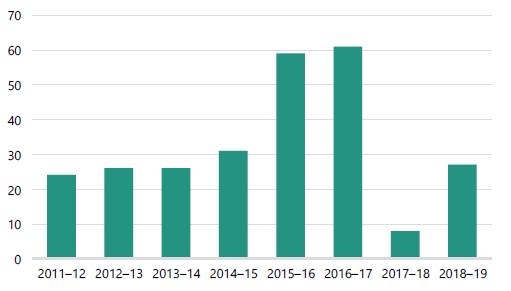
Source : VAGO, based on ERR's annual statistical reports.
Since 2016, ERR has commenced proceedings against four operators for:
- illegal quarrying activities
- a breach of mine licence conditions
- illegal works and false statements
- illegal blasting.
ERR advised us that from 2019, it has strengthened its overall compliance approach.
However, ERR has no recorded prosecutions for rehabilitation-specific breaches since 1990, when the Act was introduced.
One consequence of ERR’s failure to monitor operators’ compliance with their rehabilitation responsibilities is mining licences and work authorities may become inactive before rehabilitation works are completed or even begun. And while ERR continues to have enforcement powers until sites are closed post rehabilitation, there is usually little incentive for operators to comply with their rehabilitation responsibilities especially when bonds are less than the expected restoration costs.
This increases the state’s risk of taking on rehabilitation liabilities.
3.4 Outcomes of limited regulation
Inactive tenements
As at 30 September 2019, ERR advised that there were 231 inactive mines and quarries. That is, sites that are no longer operating, still have an operator on record, and are either undergoing, or are yet to commence, rehabilitation.
ERR does not have processes to alert it that a mine or quarry operation is likely to become inactive, other than gathering data on the mining licences that have expired, been terminated, suspended or otherwise surrendered by the licence holder.
ERR also does not have processes to effectively guide staff on how to regulate inactive mines and quarries. This results in sites remaining ‘inactive’ for an indeterminate amount of time with little or no rehabilitation taking place.
Figure 3F shows inactive tenements by licencing type, while Figure 3G shows inactive tenements grouped by the year when the licence became inactive.
FIGURE 3F: Enforcement notices issued by ERR per financial year
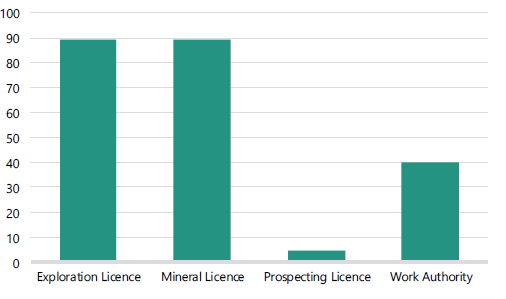
Source : VAGO, based on ERR documentation.
Inactive mine and quarry sites staying unrehabilitated
Figure 3G shows that more than 63 per cent of these sites have been inactive for more than five years. ERR has not taken effective action to ensure that licence and authority holders undertake and complete rehabilitation, despite the many years of inactivity.
FIGURE 3G: Inactive tenements grouped by year they became inactive
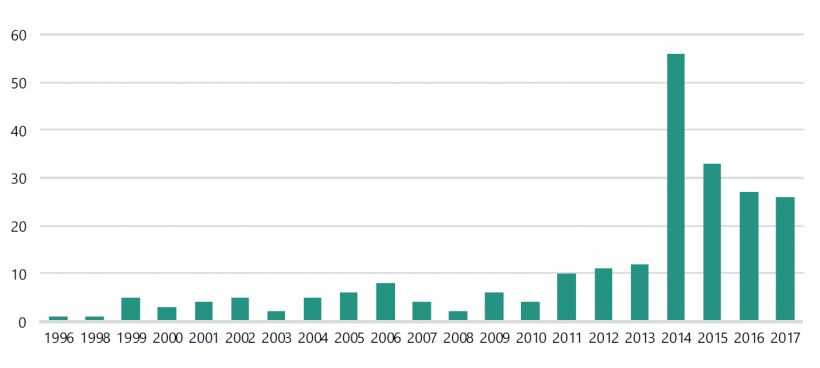
Note: ERR has no information on the number of mines that became inactive in 2018 or 2019.
Source: VAGO, based on ERR documentation.
ERR’s ineffective regulation of these mining sites is evident from ERR data, which shows that it:
- has not visited sites or reviewed the bonds of 44 per cent of these sites after they became inactive to determine if the site had been rehabilitated or was undergoing rehabilitation, and if not, to enforce rehabilitation
- has no information on when it last visited sites or reviewed the bonds of 35 per cent of these mines and quarries
- holds $3.9 million in rehabilitation bonds for all 231 inactive mines and quarries but does not know whether this is sufficient to cover rehabilitation costs.
The longer ERR takes to check and, where necessary, enforce rehabilitation the more likely the operators will not be incentivised to do so, increasing the risk of the rehabilitation liability falling on the state.
The Act does not say by what point rehabilitation should be completed after operations. It states that rehabilitation must be completed ‘as expeditiously as possible’.
DELWP confirms that there are unrehabilitated (inactive) quarry sites on Crown land that have not been operational for many years. DELWP is of the view that this is because operators see no economic benefit from restoring sites when the value of rehabilitation bonds is low.
ERR advised that while these 231 inactive mines and quarries are within its scope of regulation, it does not have adequate resources to inspect them and compel rehabilitation. Its inspectors have full workloads oversighting active sites and are unable to prioritise the rehabilitation of inactive sites.
Abandoned mines and quarries
Abandoned mines and quarries are unrehabilitated areas or sites of former mining activity where mining licences no longer exist and responsibility for rehabilitation cannot be allocated to any individual or company. ERR advised that it collaborates with DELWP and Parks Victoria to identify recently abandoned sites on Crown land for rehabilitation.
The Benambra mine in East Gippsland is an abandoned mine because ERR could not demand rehabilitation from the previous operator, who became insolvent and ceased operations in 1996. Figure 3H discusses ERR’s action to rehabilitate this abandoned mine.
FIGURE 3H: ERR action on abandoned mine—Benambra
The Benambra mine ceased operations in 1996 after the operator became insolvent. The appointed administrator failed to reopen the mine, and the mining licence expired in April 2004.
In November 2004, the then Department of Primary Industries advised the Minister for Resources that following these developments:
- the department assumed ‘full responsibility for rehabilitation of the site’ including ‘all liabilities and duty of care associated with the site’
- the mine’s $375 000 rehabilitation bond had been fully spent for initial restoration works
- the mine presented environmental risks due to its potential impact on the Gippsland waterways nearby, and its location at the head of the Tambo River catchment. These included:
- the tailings dam containing 700 000 tonnes of sulphuric material, which could generate acid leachate
- the risk of an unplanned tailings release as a result of erosion or embankment failure
- the total estimated cost for rehabilitation works was between $3 to $3.5 million.
ERR documentation shows that remedial works continued until 2016, with actual rehabilitation costs increasing to $5.6 million—significantly more than the mine’s $375 000 rehabilitation bond.
Despite the restoration work already commissioned by ERR, acid continued to drain from the previous mining site. In December 2019, ERR and EPA worked to determine how best to rehabilitate the site’ to a safe, stable and sustainable condition.
On 13 May 2020, the Minister for Resources announced the resumption of rehabilitation works at the cost of $300 000 over six months.
Source: VAGO, based on ERR documentation.
Legacy mines and quarries
Legacy mines and quarries include thousands of sites from Victoria’s gold rush and other mines and quarries from the 1850s to 1990. These legacy sites may not have been subject to any form of rehabilitation prior to closure.
DELWP and Parks Victoria are responsible for the ongoing management of legacy sites on Crown land. ERR has no legislative responsibility for legacy sites.
Information on abandoned and legacy mines and quarries
Neither ERR nor DELWP has reliable and comprehensive records on legacy and abandoned mines and quarries across the state. Consequently, they do not have a clear understanding of the:
- number of sites and areas covered
- location
- condition and their impact on the environment and nearby communities
- cost needed to rehabilitate the sites to mitigate risks to the environment, public health and safety.
These deficiencies mean that neither ERR nor DELWP has sufficient information to:
- apply a risk-based approach to managing abandoned and legacy sites
- have a statewide perspective to inform decision-making on mining rehabilitation responsibilities
- identify the actual rehabilitation liability for the state.
The 2019 Australian Senate Inquiry into the Rehabilitation of Mining and Resources Projects referred to an estimated 19 000 vacated sites in Victoria.
The report did not distinguish between sites vacated before or after 1990, so the figure refers to both legacy and abandoned sites. The report explains, however, that this estimated figure does not mean there are 19 000 abandoned or legacy mining sites, but that there were mining-related activities in 19 000 locations as evidenced by mine or quarry features, such as shafts, across the state. This means that two or more of these features could have been part of one mine or quarry site.
DELWP advised that the actual number is significantly higher. DELWP acknowledges that it does not have comprehensive information on all legacy sites on Crown land because:
- there is no centralised database for abandoned and legacy sites
- of poor historical documentation of abandoned and legacy sites.
ERR’s datasets on abandoned and legacy mines and quarries likewise suggest that there are considerably more than 19 000 abandoned and legacy mine and quarry features across the state.
Abandoned and legacy mines and quarries datasets
DJPR, through its Geological Survey of Victoria (GSV), maintains several datasets on abandoned and legacy sites for various reasons, including to:
- encourage exploration and discovery of mineral resources
- assist the public and real estate agents to determine attendant property risks on land for sale.
GSV data, however, does not provide definitive information on abandoned and legacy sites, for reasons including:
- double counting
- incompleteness (does not cover the whole state)
- out-of-date information
- no information relating to site condition and risks, including whether identified sites have already been rehabilitated.
GSV advised that it updates its datasets as new information becomes available.
No statewide approach to manage abandoned and legacy mines and quarries
There is no statewide approach to manage abandoned and legacy mines and quarries to reduce environmental, public health and safety risks. There is also no agreement on which agency is in charge of overseeing the management of liabilities, including whether work had been completed to agreed standards.
The result has been an ad hoc, uncoordinated and reactive approach to managing abandoned and legacy mining sites across the state.
Better-practice management of abandoned and legacy sites
Victoria is not as well placed as other jurisdictions to manage the risks from abandoned and legacy sites. Components of better practice in other jurisdictions are not in place in Victoria.
According to the Council of Australian Governments Resources Policy Group’s 2019 Report on Former Mines Management in Australian Jurisdictions, Australian jurisdictions vary in how well established their respective abandoned and legacy sites programs are, particularly in relation to:
- abandoned and legacy sites policies
- risk assessment matrices
- established databases for abandoned and legacy sites
- dedicated funding for the rehabilitation of abandoned and legacy mines
- designated abandoned and legacy sites agency branches or units
- assessment panels for approving capital works projects.
This report also identifies a number of areas of best practice in some jurisdictions, including:
- initial screening of sites to determine highest priorities based on proximity to sensitive receptors such as residential areas, waterways and national parks— Western Australia
- leading practice data collection and management—New South Wales
- development of a site-specific risk register—Canada.
Victoria has none of the above better-practice approaches to managing risks from legacy and abandoned sites.
Clarity of roles and responsibilities
DELWP and DJPR advised us on their shared agreement as follows:
- DELWP is responsible for legacy mines and quarries on Crown land.
- The Minister for Resources may take action to rehabilitate land if it is not satisfied that rehabilitation has been undertaken appropriately and the licence holder or former licence holder has failed to do so in a reasonable time.
- Going forward, DJPR, in partnership with DELWP, will typically lead rehabilitation works on abandoned sites on Crown land.
- DELWP would not immediately take on responsibility for all abandoned mines and quarries on Crown land as there may be bonds or other consolidated funds available to DJPR to rehabilitate the site.
DELWP and ERR are working on a joint departmental statement regarding their shared position on managing legacy and abandoned sites on Crown Land. They advised that this statement will be published by 31 December 2020.
DELWP action on legacy mines and quarries
DELWP advised that its regional officers come across legacy sites in the course of other work, such as managing bushfire risks, implementing weed and pest programs or providing recreational services. In these cases, if the site poses a risk to human health and the environment, the DELWP officers work to manage the risks through methods including fencing, backfilling, capping or grate installation.
For example, in 2017, DELWP regional officers inspecting Crown land in Long Gully, Bendigo came upon an uncapped mine shaft that DELWP had not known about. A nearby primary school meant that children may walk through the area on their way to school. DELWP immediately sealed the shaft to improve public safety.
In general, however, there is no centralised and statewide coordinated plan within DELWP to manage legacy sites on Crown land. This means that the work done by regional offices to manage legacy sites is not coordinated and does not utilise a uniform approach.
DELWP advised us that:
- there is no single group in the central Melbourne office that has oversight of all legacy sites on Crown land
- it does not have a consistent approach to managing legacy mining sites
- it does not centrally track the spending for mining rehabilitation activities and that tracking is inconsistent across regions
- it has no dedicated funding for managing legacy site risks across the state, and regional offices use funding for other programs to implement rehabilitation works.
Bendigo groundwater and waterways
DELWP advised that all creeks and waterways in Bendigo are impacted by legacy mining, and most are in poor condition with high concentrations of heavy metals and arsenic.
Bendigo’s mining area consists of seven major gold-bearing mine sites with approximately 5 000 shafts. Most of these mines are shallow, but some are over 500 metres deep and a few over 1 000 metres deep.
Because Bendigo has a naturally shallow groundwater table, the historic mine shafts and voids under the city provide preferential flow paths for groundwater and focus discharges from low-lying sites into waterways and creeks. Consequently, groundwater in the mine workings has high levels of arsenic, heavy metals and sulphides, which release a rotten egg odour.
Historically, bailing and groundwater pumping were used to suppress groundwater levels when legacy mines were operational. But when mining stopped and pumping ceased, groundwater levels rose to their naturally shallow levels. This caused contaminated water to discharge from mine shafts into Bendigo’s groundwater and waterways.
When mining briefly resumed in Bendigo from the 1990s until 2011, lowered groundwater levels reduced contaminated water discharges and odour issues. But when mining ceased in 2011, groundwater levels began to rise again and the Bendigo community was concerned that, without intervention, this would again result in contaminated groundwater discharging into Bendigo’s waterways.
DELWP has been dealing with this issue since 2013 by facilitating and funding the temporary management of contaminated groundwater.
New approach to managing contaminated land
DELWP advised that it is developing a new approach to better manage risks associated with contaminated land, including abandoned or legacy mine sites.
This work is in response to the introduction of the Environment Protection Act 2017 (as amended), which imposes a duty on DELWP, as Crown land manager, to manage contaminated land and minimise risks to human health and the environment as far as reasonably practicable.
To determine what is reasonably practicable to minimise the risk of harm to human health and environment, DELWP must consider:
- the likelihood of those risks eventuating
- the degree of harm that would result if those risks eventuated
- what the person concerned knows, or ought reasonably to know, about the harm or risks of harm and any ways of eliminating or reducing those risks
- the availability and suitability of ways to eliminate or reduce those risks
- the cost of eliminating or reducing those risks.
However, before DELWP can undertake this assessment, it needs to better understand:
- the extent, location and condition of abandoned and legacy sites on Crown land, as well as
- the cost required to mitigate risks to human health and the environment.
DELWP’s limited available information presents a challenge in meeting its new legislative duty to manage contaminated land. The new environment protection framework encourages duty holders to build knowledge and address issues using a risk-based approach to minimise risks to human health and the environment as far as reasonably practicable.
No comprehensive records on rehabilitation work and costs
Other than for rehabilitation of the Benambra mine in East Gippsland, ERR is unable to advise of other instances when the state rehabilitated mines or quarry sites under the Act.
When we requested this information, ERR provided a list of 19 mines and quarries whose bonds were allegedly called in to finance the sites’ rehabilitation. However, the list does not include information on whether rehabilitation was completed or even commenced. Moreover, ERR’s data shows that none of these bonds have in fact been called in by ERR.
ERR further acknowledges that it has not prosecuted any licence holder to enforce rehabilitation or to recoup additional costs of rehabilitation incurred by the state where either ERR or DELWP has undertaken rehabilitation works.
DELWP
DELWP does not centrally record rehabilitation work conducted, nor the corresponding expenditure, by its regional offices. We found that there is also varying degrees of record keeping for this in DELWP’s regional offices.
Available records suggest that DELWP’s Grampians region spent some $75 000 from 2010 to 2018. And in Bendigo, DELWP committed $30 million for the groundwater and waterways projects, discussed previously, to manage this issue until June 2021. DELWP is working with the community and responsible agencies to identify options for longer-term management approaches, the costs of these options and appropriate funding sources.
4. Regulator readiness
Conclusion
ERR’s actions—particularly over the last 18 months—have begun to address identified weaknesses in its regulatory approach and improve its management of longstanding issues with the rehabilitation of mines and quarries.
However, ERR has further work to do to ensure its policies and guidance documents and its information management system provide the necessary instruction, data and processes to support it to be an effective regulator and reduce risk to the state from unrehabilitated mine and quarry sites.
This chapter discusses:
4.1 Overview
Following the recommendations of the 2014 Hazelwood Mine Fire Inquiry and other government reviews highlighting issues with the regulation of mining in Victoria, ERR began improving its regulatory performance in 2015.
ERR continues to work on equipping itself to be an efficient and effective regulator of the earth resources sector.
4.2 Policies and procedures
ERR’s policies and procedures do not enable it to effectively oversee the sector and financially incentivise mining operators to comply with their rehabilitation responsibilities.
ERR is aware of this issue. Its 2019 internal audit report found that while ERR has a considerable number of policies and guidance documents, they are:
- fragmented, and do not link into a broader framework
- often out of date
- inconsistently applied by staff
- generally not used, as many staff are unaware of their existence.
This has resulted in blurred accountabilities, inconsistent application across regional offices and weak oversight, which inhibit ERR from effectively implementing the requirements of the Act.
ERR agreed with the internal audit recommendations that it needs to develop:
- an overarching rehabilitation strategy to underpin a revised governance structure
- comprehensive controls to support compliance with its legislative and regulatory rehabilitation responsibilities.
Standard operating procedures
In June 2018, ERR started developing SOPs to guide staff on consistent regulatory practices. As at 20 September 2019, ERR had completed 47 SOPs, 14 of which were ready for implementation.
However, other than the 2019 Rehabilitation Bond Review Operational Policy and the February 2020 Preparation of Rehabilitation Plans: Guideline for Mining and Prospecting Projects, ERR’s SOPs do not provide specific procedures and controls to manage rehabilitation responsibilities.
For example, the 2019 SOP #36: Review of Annual Reports focuses on checking whether operators submit an annual return. There is no procedure to check if operators include required information on rehabilitation. Furthermore, there is no evidence that ERR is verifying the rehabilitation works reported by operators.
ERR advised that these details will be covered in a work instruction that is yet to be developed. It said that a SOP is not the right document to explain this activity.
It is our view that to avoid duplication and confusion, all the necessary information and guidance on one topic should be in one document that is easily available to all staff. Therefore, for ease of use and to improve compliance, all the necessary steps should be included in the SOP.
In addition, none of the completed 47 SOPs provide guidance on:
- setting the value of rehabilitation bonds
- reviewing rehabilitation bonds
- monitoring and enforcing progressive rehabilitation
- regulating inactive sites and managing abandoned sites
- assessing final rehabilitation work prior to returning rehabilitation bonds.
Rehabilitation Strategy 2020
On 7 February 2020, the Minister for Resources approved ERR’s Regulatory Practice Strategy for the Rehabilitation of Earth Resources Sites. This document outlines ERR’s rehabilitation responsibilities through the whole mine and quarry life cycle.
This should help ERR better manage its mining rehabilitation regulatory responsibilities.
However, the strategy is not underpinned by an evaluation and reporting framework that lays out performance indicators or reporting protocols to track and report on ERR’s progress in achieving intended outcomes.
4.3 Information management system
ERR has no centralised information management system that comprehensively holds mining rehabilitation information.
Where information is available, it is held in fragmented systems across ERR offices. There is no easy way to collate information to provide an auditable trail of compliance with mining rehabilitation requirements.
An audit commissioned by ERR in 2017 found that ERR needs to significantly improve the way it manages documentation, records and information. ERR accepted all the recommendations and set a target of October 2017 to implement them. However, a second audit commissioned by ERR in early 2019 found that the issues identified in the 2017 audit were yet to be addressed.
We found that ERR’s information management system is still limiting its ability to effectively manage rehabilitation liabilities and related documentation about authority holders and applicants. ERR continues to work on implementing the recommendations of both internal audits.
ERR’s internal audits identified the following issues:
- No ERR-wide SOP for document retention and management, resulting in inconsistent and siloed document management practices.
- Inconsistencies and regional variations in document management and not all information was stored in the various ERR network drives. Instead, staff stored documents in personal computer drives, and paper folders.
- Fragmented document storage across multiple systems and not all evidence available for the purpose of providing an audit trail of tenement documentation. This has resulted in missing documentation and increased risk of collected information being fragmented, incomplete, inaccurate or out of date.
- ERR’s electronic document management system was not compliant with the Public Records Act 1973, the Evidence Act 2008, Financial Management Act 1994, and the Electronic Transactions Act 2000, and was therefore unfit to meet its document retention and management requirements.
We found the same difficulties with accessing information and documentation when conducting our audit. It was difficult to find out whether a document existed, and whether the documents provided were final and approved.
Digitisation program
In December 2019, ERR approved a Digitisation Plan to enable hard copy tenement files to be legally and securely destroyed after digitisation. ERR advised that this will be an ongoing process. The plan intends to digitise:
- letters containing signatures
- original documents received in hard copy
- work plans
In February 2020, ERR approved a project to create a new platform to replace its current electronic document management system, aiming to address its limitations. The project is scheduled to be completed by 31 December 2021, subject to funding availability.
4.4 ERR resourcing
Roles and responsibilities within ERR
Until recently, there has been a lack of clarity on roles and responsibilities within ERR. Examples of this confusion include:
- no clear lines between business units, so that staff who assess work plan applications are also tasked with compliance monitoring responsibilities
- not having a unit within ERR to look into assessing mine and quarry sites’ rehabilitation liabilities.
The restructure of ERR in 2016 established clearer lines between units such that those responsible for compliance monitoring no longer also assess work plan applications.
In 2019, ERR completed its Assignment of Rehabilitation Responsibilities as summarised in Figure 1E. This led to the establishment of the Rehabilitation Liability Assessments and Bonds unit, which is tasked to focus on the assessment of rehabilitation liabilities. No similar unit was previously in place at ERR. As at March 2020, however, the unit had only one team member.
While roles and responsibilities within ERR have largely been clarified, ERR still needs to address issues with its resourcing, its MoUs with DELWP and EPA, and its coordination with LVMRC and catchment management authorities.
Staffing
ERR sits within the Resources branch of DJPR, with staff based in Melbourne, Ballarat, Epsom, Benalla, Traralgon and Ellinbank.
ERR’s organisational structure for the 2019–20 financial year provides for 70.7 FTE employees with:
- one FTE assigned to assessing rehabilitation liabilities and setting bonds
- nine FTE assigned to a range of functions, one of which is to assess work plans, including the approval process for rehabilitation plans
- 18 FTE assigned to monitoring and enforcing compliance, supported by two positions allocated to investigations.
ERR advised that lack of staff is a significant hurdle in performing its rehabilitation responsibilities. Only one staff member is responsible for rehabilitation liability assessments and ERR staffing has not increased despite an increased workload.
In 2019, DJPR’s Resources branch commissioned a review of its workforce capabilities and capacity to inform future resource planning for its various units. The November 2019 report for this review noted that:
- ERR’s workload has sharply increased due to high demand for quarry materials and more mineral production, which has created capacity issues in mining rehabilitation, regulatory compliance, investigations, assessments and risk management
- the ratio of inspectors to sites and active issues does not allow for effective regulation and compliance, and the backlog of work is growing.
Additional resourcing requirements
From 30 June 2020, the new Mine Land Rehabilitation Authority assumed the functions of LVMRC. The authority’s role includes overseeing the implementation of the Latrobe Valley Regional Rehabilitation Strategy and contributing more broadly to safe, stable and sustainable rehabilitation solutions.
Despite the increased workload, ERR staffing has not increased.
To determine its staff requirements, ERR’s Senior Management Committee conducted a workshop to consider current and anticipated future workload requirements. Through this process, DJPR assessed that it needs 25.1 more FTE staff to address resourcing gaps in rehabilitation regulation. Specifically, to:
- complete its assessment of gaps between actual bonds held and estimated rehabilitation liabilities
- improve compliance monitoring through rehabilitation-specific inspections and audits, including post-closure assessments
- reassess rehabilitation liabilities with the updated bond calculator
- better manage the approval process through the review and assessment of work plans and work plan variations
- establish the Mine Land Rehabilitation Authority as required by the Act.
DJPR’s breakdown of its additional staff requirements is laid out in Figure 4A.
FIGURE 4A: Additional staffing requirements for 2020─21 to 2023─24
| Task | Additional FTE required |
|---|---|
| Project and systems management—implementation of responses to rehabilitation audits and digitisation of records | 2.8 |
| Assessments and technical services—assessment of work plans including rehabilitation plans | 7 |
| Operational policy—establishment of up to date standard operating procedures, work instructions, guidelines, MoUs | 1.4 |
| Rehabilitation liabilities—assessment of rehabilitation liabilities and review of bonds. | 3.9 |
| Compliance—implementation of rehabilitation-specific monitoring audits and inspections and post-closure assessments | 4 |
| Office of the Mine Land Rehabilitation Authority | 6 |
| Total | 25.1 |
Source : VAGO, based on ERR documentation.
4.5 Clarity of responsibilities across agencies.
On the whole, responsible agencies have a clearer understanding of their roles and responsibilities within the earth resources sector following ERR’s implementation of recommendations from various reports:
- ERR’s Compliance Strategy 2018–2020 provides for the respective roles and responsibilities of ERR, DELWP, EPA and other agencies.
- In 2016, ERR formed the Earth Resources Regulator Forum to facilitate a coordinated approach to earth resources regulation. The forum meets three times each calendar year.
- MoUs set out roles and coordination points between ERR and DELWP, as well as between ERR and EPA.
Figure 1I lists relevant agencies’ responsibilities.
MoU with DELWP
ERR and DELWP need to replace their 2011 MoU, which expired in 2016 but is still in use. It refers to outdated section numbers of the Act and its regulations.
DELWP noted that the next MoU should clarify which agency is responsible for:
- regulating water quality during rehabilitation
- facilitating the transfer of water quality risk at the end of mining licences
- monitoring and implementing rehabilitation of abandoned sites
- covering the orderly transfer of responsibility for abandoned sites back to the Crown land manager.
The 2011 MoU did not provide guidance on these issues.
ERR’s MoU with DELWP is also silent on responsibilities for:
- providing feedback to DELWP on whether and how its comments to mining or quarrying applications are considered by ERR
- the rehabilitation bond consultation process
- coordinating the progress of progressive rehabilitation and final rehabilitation for sites on Crown land
- sharing relevant information and records relative to operators’ rehabilitation activities where DELWP is the Crown land manager.
DELWP and ERR advised that they are working to develop the next MoU. Neither agency has advised when this will be completed.
MoU with EPA
The 2018 MoU with EPA does not reflect the Environment Protection Act 2017 (as amended), which provides for the mandatory referral of mining work plans to EPA where a planning permit is required. EPA and ERR began implementing this change on 1 July 2019 and are now updating the MoU to incorporate the mandatory referral.
EPA advised that while it provides input to work plans and rehabilitation plans, it does not have a direct role in monitoring or providing advice on actual rehabilitation works.
The current MoU notes that EPA provides specialist advice and support, consistent with its expertise and regulatory skills, when dealing with offsite environmental and health impacts such as dust, noise and contamination.
EPA advised that while it is satisfied with its working arrangements with ERR, it continues to look for opportunities to enhance processes to ensure good environmental outcomes.
Latrobe Valley Mining Rehabilitation Commissioner
LVMRC was established in May 2017 as a statutory office to monitor and audit Latrobe Valley mine rehabilitation. Although our audit scope excludes coal mines in the Latrobe Valley—as DJPR and DELWP were developing the Latrobe Valley Regional Rehabilitation Strategy during the audit—the audit consulted LVMRC on the current rehabilitation regulatory practice.
LVMRC advised that the bond calculator for Latrobe Valley coal mines does not consider water-related and research costs, which are relevant for successful rehabilitation.
LVMRC also noted that the technical competencies of ERR site inspectors vary and that some do not have the required technical capability to effectively inspect and assess sites. It also noted that the site inspections should not be treated as a simple compliance exercise. Inspectors should be able to provide consistent and timely feedback on rehabilitation progress.
ERR advised that it has been working to enhance the technical skills of its inspectors. Its in-house Technical Services team which includes a mine engineer, a geotechnical engineer and hydrogeologist, as well as external technical specialists who, when needed, support its inspectors’ compliance operations.
Goulburn Broken Catchment Management Authority
ERR refers work plan applications to GBCMA when the proposed mining or quarrying site is covered by council planning schemes’ floodway zones or overlays.
There is no MoU between ERR and GBCMA, nor other catchment management authorities. GBCMA advised that while it believes that the clarity of roles and responsibilities is not an issue, ERR procedures do not enable GBCMA to appropriately assess applicants’ preliminary work plans for their proposed mining or quarrying activities. For example, GBCMA believes that having access to preliminary work plans before the onsite consultation meeting with the licence or work authority applicant could help clarify potential environmental issues.
GBCMA note that having this information at this earlier stage of the application process would assist the parties to better identify and discuss environmental concerns.
Quarries within GBCMA’s jurisdiction
DJPR has identified most of the floodplain of the Goulburn River as a source of gravel for Melbourne. GBCMA is concerned that sustained quarrying in the area will have significant environmental implications for the Goulburn River, and pose risk to people, land, and infrastructure.
GBCMA commissioned an environmental assessment in 2015 that showed pit capture is a genuine concern for the nine quarries within GBCMA’s jurisdiction. It is also concerned that the scale of quarrying operations and their close proximity to the Goulburn River and key infrastructure indicate that significant physical and infrastructure impacts will continue to occur.
As at December 2019, ERR has only assessed two of these quarries—one as a high rehabilitation risk, and the other as medium. The rehabilitation bonds for these nine quarries, ranging from $8 000 to $511 000, do not reflect the significant rehabilitation risks that GBCMA has identified.
ERR advised that when the bonds for these quarries were set, mostly in the 1990s, there was no requirement to consider post closure risks when establishing the bonds. This highlights the need for ERR to consult GBCMA when it reviews the bonds for these quarries.
Councils
While ERR has two guidelines for local government councils on assessing extractive industry and mining licenses, these guidelines date back to 2006 and need to be refreshed to incorporate the current regulatory requirements.
4.6 Remedial actions in progress
Deficiencies in ERR’s regulatory practice and governance
A December 2015 internal audit highlighted deficiencies in ERR’s regulatory practice and governance arrangements. These included:
- unclear governance arrangements—lack of clarity around roles and responsibilities both within ERR and with co-regulators
- consistency of decision-making—lack of internal processes and systems to support consistency and information sharing
- ineffective information management—primary data management tool inadequate to support data collection and analysis and information sharing
- insufficient capability—it lacks some key capabilities such as geotechnical expertise and data analytics
- weak quality assurance—internal quality assurance processes were less robust than leading practice comparators, leading to poor regulatory decision-making and oversight.
DJPR accepted the recommendations of this report, and ERR began a series of reforms, including a restructure in 2016 that established a regulatory governance team within ERR.
Internal audits
In 2017, ERR commissioned an internal audit to determine the effectiveness of its regulation of mining site rehabilitation. The March 2018 report noted that at the time of the audit, ERR had developed ‘fit-for-purpose processes and controls to oversee site rehabilitation’.
In 2018, ERR commissioned another internal audit with the same terms of reference. ERR documentation said that it was ‘not satisfied that [the] earlier audit adequately examined’ its processes and controls.
The March 2019 report of this second internal audit noted that:
- A policy framework for rehabilitation liabilities could not be identified.
- The bond calculator underestimates rehabilitation liabilities.
- Information management is fragmented and/or not undertaken.
ERR accepted the findings of the March 2019 report and committed to developing an implementation plan by September 2019 to action the same.
Rehabilitation Improvement Project Plan
The September 2019 Rehabilitation Improvement Project Plan outlines actions to address the key areas for improvement identified by the 2019 internal audit. Key action items include:
- developing an overarching rehabilitation policy
- developing policies, SOPs and work instructions
- developing and updating rehabilitation bond calculators and a methodology
- initiating a program of rehabilitation bond reviews
- developing rehabilitation risk profiles for mines and quarries
- clarifying roles and responsibilities regarding rehabilitation management
- establishing clear procedures and training for regulatory staff to ensure consistent application of policies and practice
- improving the management of public records
- building an enforcement capability and culture
- developing evidence-based risk profiles for sites and compliance and enforcement activities.
The implementation of these initiatives is at various stages of completion.
ERR is taking serious and considerable effort to implement these actions to improve its oversight of work plans and rehabilitation bonds.
However, this plan does not include action items to address the lack of processes and procedures to address and manage issues relative to:
- abandoned mines and quarries
- inactive mines and quarries
- site closure and post closure
- return of rehabilitation bonds.
These matters are within ERR’s responsibilities as the state’s primary mining regulator and need equal attention.
Other government reviews
ERR has also been implementing recommendations from a number of government reviews.
|
Inquiry or review |
Recommendations |
ERR reported action |
|
Independent inquiry into the EPA 2016 |
Strengthen mining regulation by:
|
Has set up the Earth Resources Regulation Forum for cross agency coordination. Has established the Technical Review Board. Has finalised the Earth Resources Regulation Compliance Strategy 2018–2020. Has revised the rehabilitation bond policy for the Latrobe Valley mines. Is preparing to update the MoU with EPA. |
|
2014 Hazelwood Report |
Implement 16 actions, of which 6 related to rehabilitation. |
Has completed 5 of 6 rehabilitation actions relative to Latrobe Valley mine rehabilitation, as at 12 December 2019:
|
|
2017 Getting the groundwork right—better regulation of mines and quarries |
Improve operational practices to facilitate quicker and more positive outcomes. The immediate priority was to rapidly assess and treat the considerable backlog of applications for licences, work authorities and work plan approvals sitting with ERR. |
Has reduced application backlog. Has published new guidelines for work plan preparation and variation. Has streamlined the licence approval process. Electronic document management system quick wins project delivered. Commenced developing work plan notification pathway. Is in the process of implementing newly established SOPs. |
ERR continues to implement the recommendations of these government reviews.
Appendix A. Submissions and comments
We have consulted with DELWP, DJPR, EPA, GBCMA and LVMRC and we considered their views when reaching our audit conclusions. As required by the Audit Act 1994, we gave a draft copy of this report, or relevant extracts, to those agencies and asked for their submissions and comments. We also provided a copy of the report to the Department of Premier and Cabinet and the Department of Treasury and Finance.
DJPR and DELWP accepted all the recommendations addressed to them. The audit did not address recommendations to EPA, GBCMA and LVMRC.
Responsibility for the accuracy, fairness and balance of those comments rests solely with the agency head.
RESPONSE provided by the Secretary, DELWP
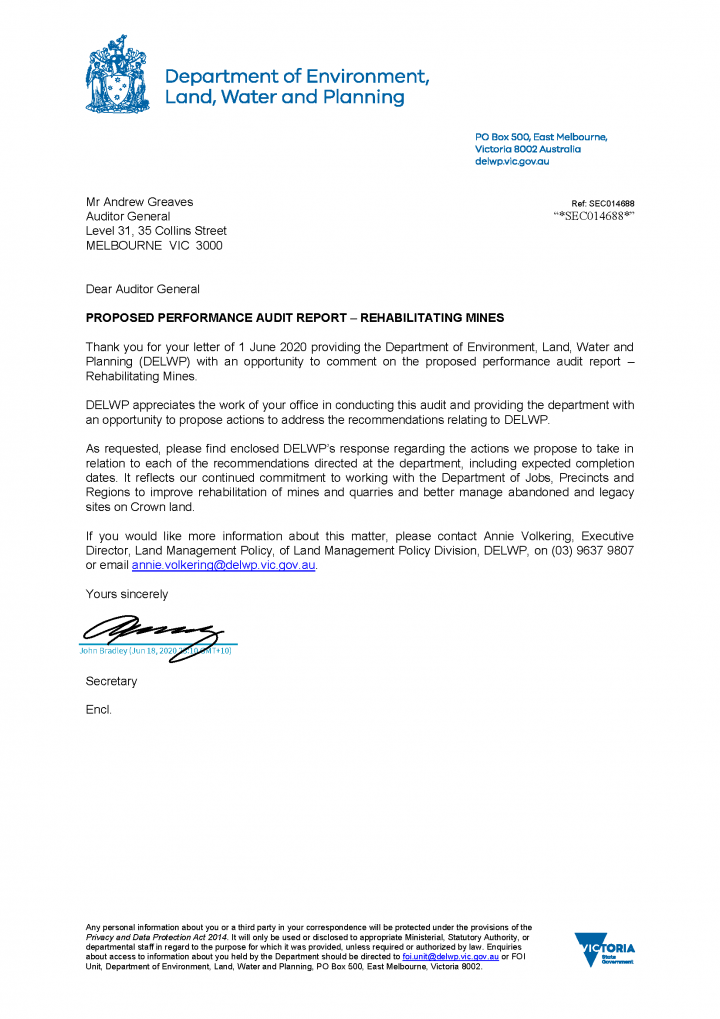
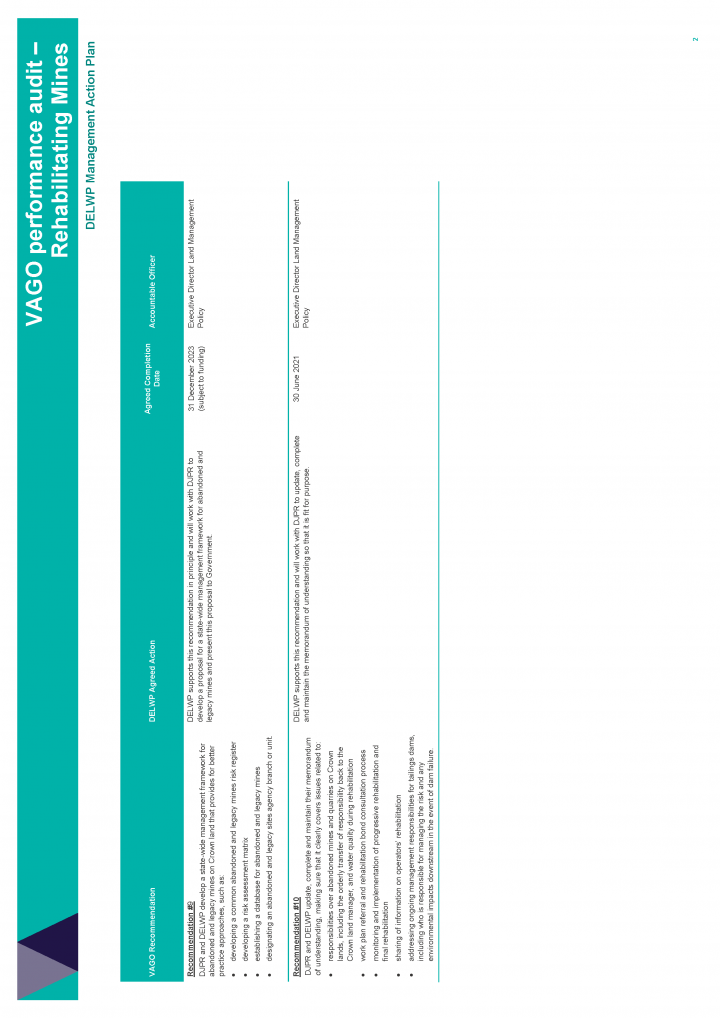
RESPONSE provided by the Associate Secretary, DJPR
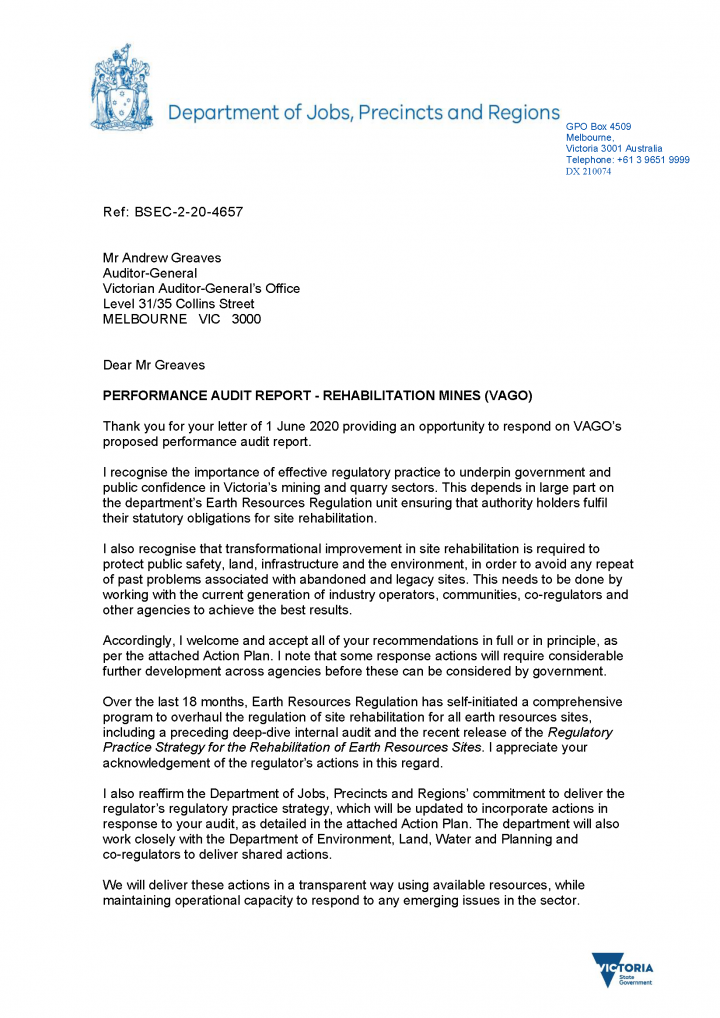
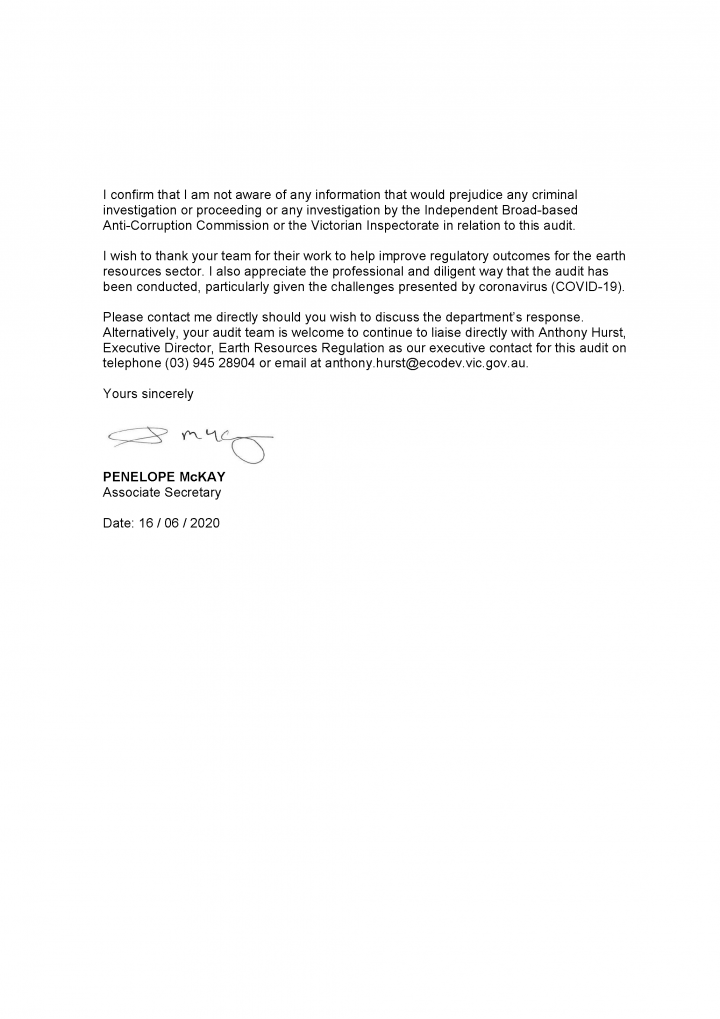
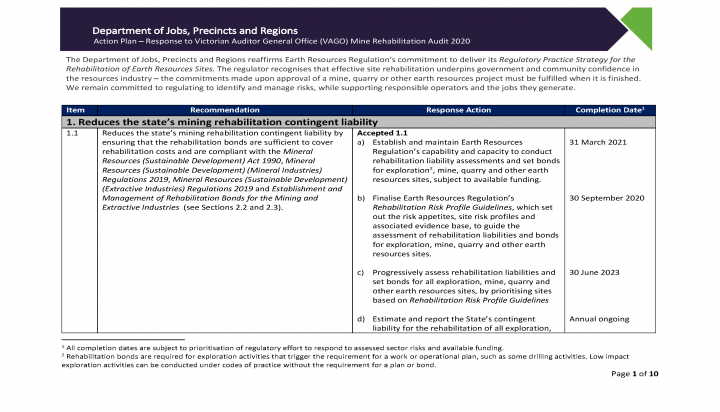
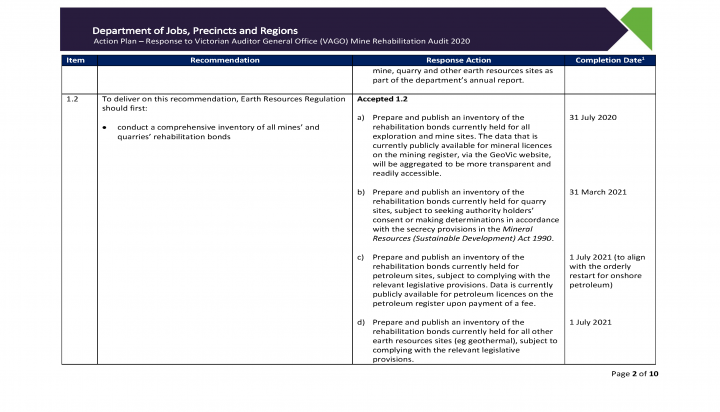
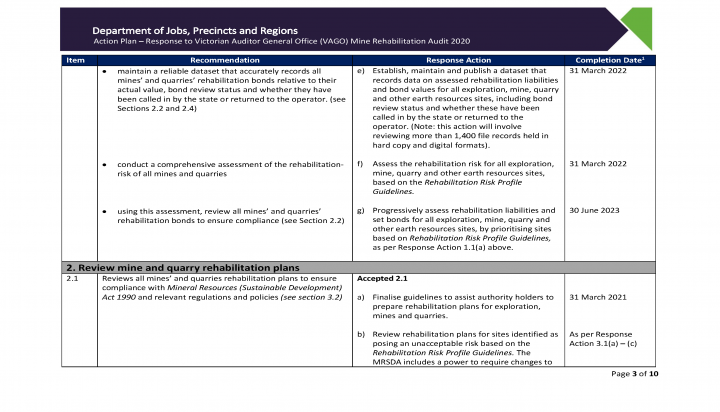
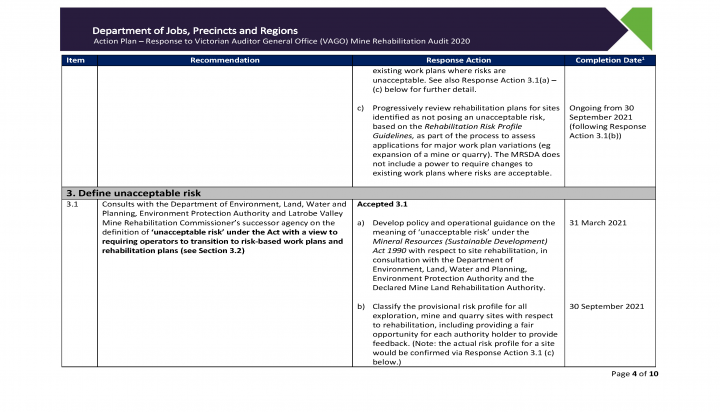
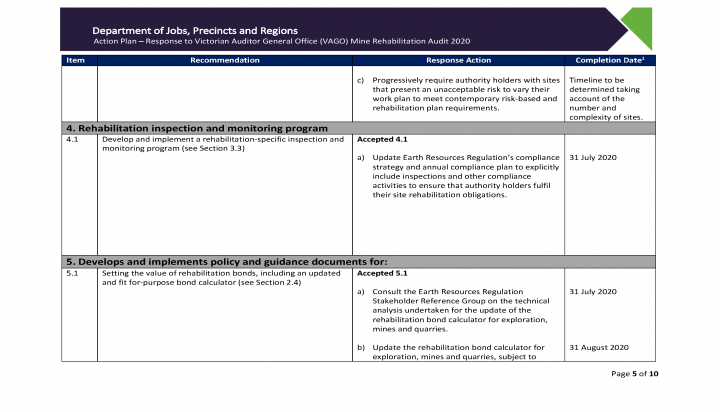
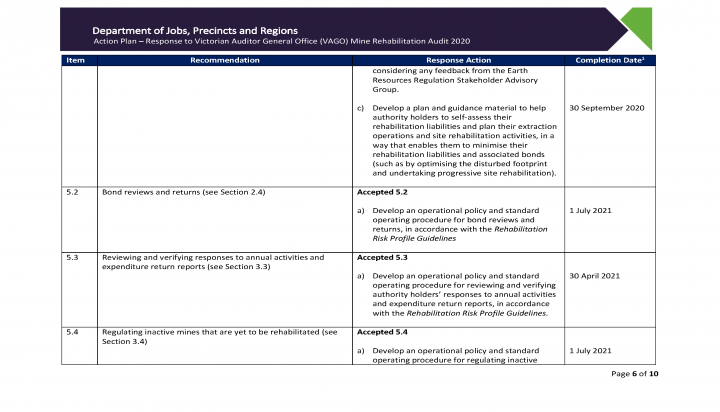
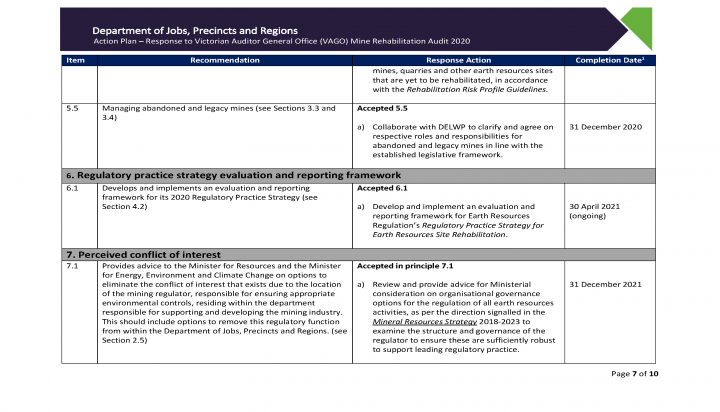
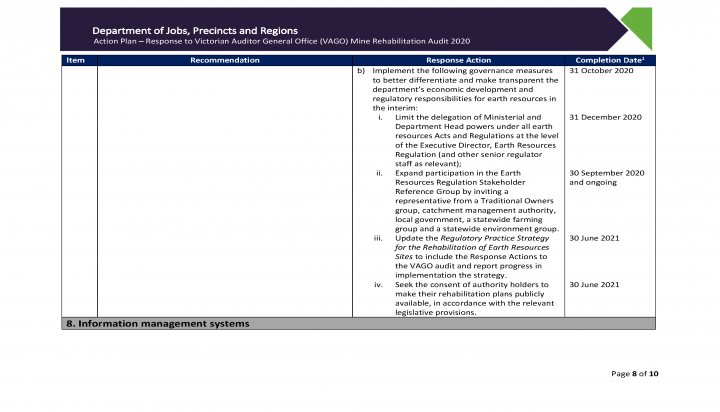
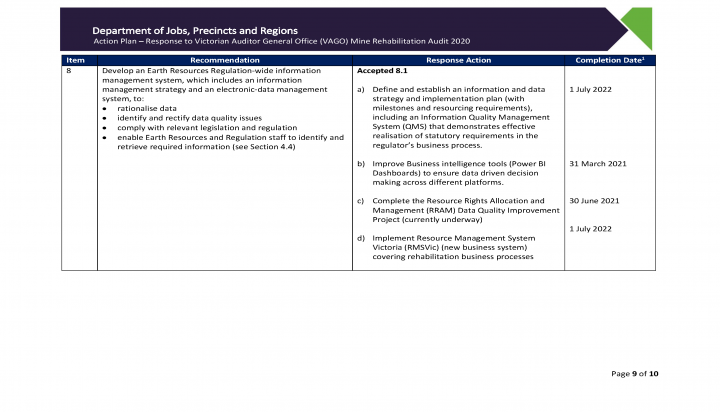
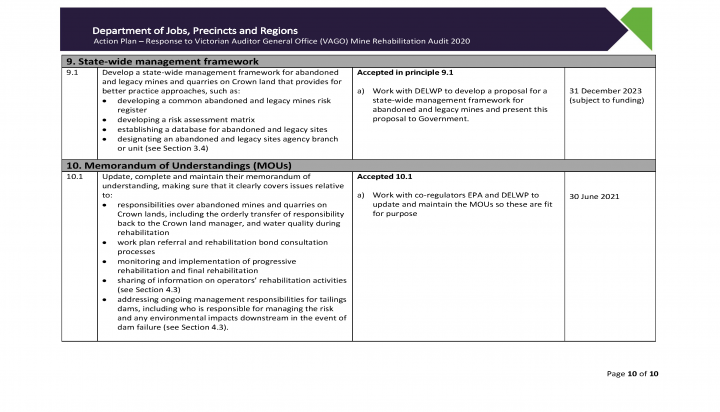
RESPONSE provided by the Executive Director, EPA
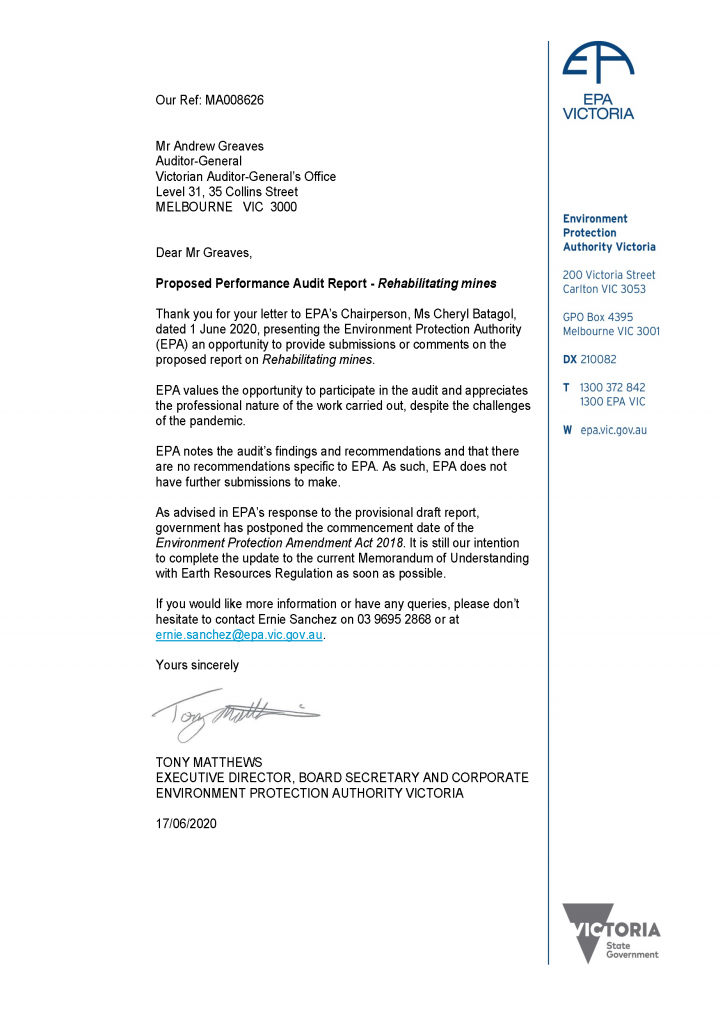
RESPONSE provided by the Chair, GBCMA
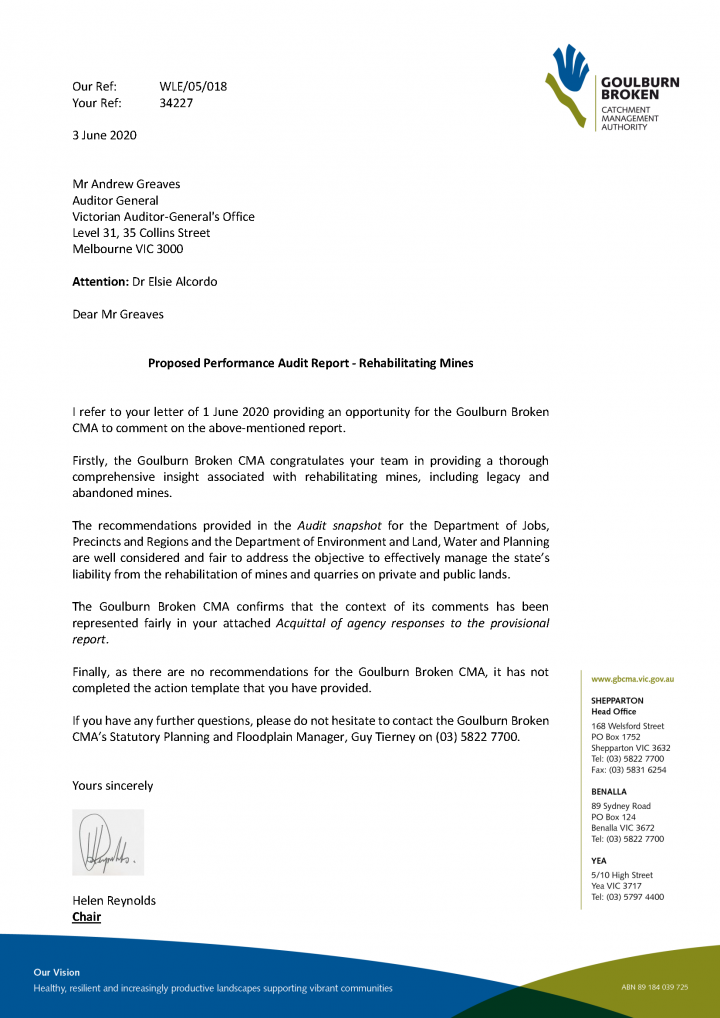
Appendix B. Acronyms and Abbreviations
| Acronyms | |
|---|---|
| CL | contingent liability |
| DEDJTR | Department of Economic Development, Jobs, Transport and Resources |
| DELWP | Department of Environment, Land, Water and Planning |
| DJPR | Department of Jobs, Precincts and Regions |
| ERR | Earth Resources Regulation |
| EPA | Environment Protection Authority |
| FTE | full-time equivalent |
| GBCMA | Goulburn Broken Catchment Management Authority |
| LVMRC | Latrobe Valley Mine Rehabilitation Commissioner |
| MoU | memorandum of understanding |
| MRSDEIR | Mineral Resources (Sustainable Development) (Extractive Industries) Regulations 2019 |
| MRSDMIR | Mineral Resources (Sustainable Development) (Mineral Industries) Regulations 2019 |
| SOP | standard operating procedure |
| VAGO | Victorian Auditor-General’s Office |
|
Abbreviations |
|
|---|---|
| Bond Policy | Establishment and Management of Rehabilitation Bonds for the Mining and Extractive Industries |
| the Act | Mineral Resources (Sustainable Development) Act 1990 and its subsequent amendments |
Appendix C. Scope of this audit
| Who we audited | What we assessed | What the audit cost |
|---|---|---|
| DJPR DELWP EPA GBCMA LVMRC |
We assessed:
|
The cost of this audit was $570 000. |
Our methods
The objective of this audit is to determine whether the state is effectively managing its exposure to liabilities from the rehabilitation of mines and quarries on private and public land.
The audit focused on DJPR’s regulatory activities and whether these are effectively driving operators’ compliance with the Act to achieve regulatory rehabilitation outcomes. It also looked into DJPR’s coordination with relevant agencies, including DELWP, EPA, LVMRC and GBCMA.
The audit did not examine DJPR’s regulation of petroleum and geothermal sites, nor did it examine coal mines in the Latrobe Valley. This is because DJPR and DELWP were developing the Latrobe Valley Regional Rehabilitation Strategy during the audit. The Minister for Resources released the strategy on 26 June 2020.
Notwithstanding, references to the Latrobe Valley coal mines, such as their rehabilitation bonds given their significant values relative to total bonds held by the state, and the findings and recommendations of the 2014 and 2016 Hazelwood mine inquiries) are appropriately made at various parts of the audit.
We conducted our audit in accordance with the Audit Act 1994 and ASAE 3500 Performance Engagements. We complied with the independence and other relevant ethical requirements related to assurance engagements.
